#textile design jobs sydney
Text
Sydney Fire Extinguishers: Types and Uses
In Australia, fires can cause devastating damage to homes, businesses, and communities. Having the right type of fire extinguisher readily available can mean the difference between a small, contained fire and a disaster. In this article, we will explore the different types of fire extinguishers and their importance in Sydney, Australia.

There are five main types of fire extinguishers: water, foam, dry powder, carbon dioxide, and wet chemicals. Each type of fire extinguisher is designed to put out specific types of fires, and it's important to choose the right one for the job.
Water Extinguishers: These extinguishers are best used for Class A fires, which involve solid materials such as wood, paper, and textiles. Fires classified as Class B or C are not recommended for them.
Foam Extinguishers: Foam extinguishers are used for Class A and Class B fires, which involve flammable liquids and gases. The foam creates a barrier between the fire and the fuel source, smothering the flames.
Dry Powder Extinguishers: Dry powder extinguishers are used for Class A, B, and C fires, making them a versatile option. They work by smothering the fire and interrupting the chemical reaction that is causing the flames.
Carbon Dioxide Extinguishers: Carbon dioxide extinguishers are used for class B and class C fires. They work by taking away the oxygen that the fire needs to burn.
Wet Chemical Extinguishers: Wet chemical extinguishers are used for Class F fires, which involve cooking oils and fats. They work by creating a barrier between the fire and the fuel source and cooling the flames.
It's important to have the right type of fire extinguisher for your home or business, and to make sure that it is easily accessible in case of an emergency. Regular maintenance and inspections should also be carried out to ensure that the fire extinguisher is in good working order.
In conclusion, having the right type of fire extinguisher can be the difference between a small, contained fire and a disaster. Make sure you have the right type of fire extinguisher for your needs, and that it is regularly maintained and inspected to ensure that it is ready to use in case of an emergency. Stay safe, Sydney!
Feel free to contact us with any emergencies or queries. At Eva Fire Protection, we are always here to help and provide you with the best possible solutions and suggestions. Our experienced team is available 24/7 to ensure your safety and provide the fire protection services you need. Don't hesitate to reach out to us at any time.
#fire prevention#fire protection#fire safety#fire#fire extinguisher#fire safety certificate#fire safety equipment#fireextinguishers#fire safety systems#fire safety australia
1 note
·
View note
Text
The love story that survived The Holocaust
After reading The Tattooist of Auschwitz, I was inspired by Lale’s story and his ability to remain hopeful despite his situation. The following is a very short biography of him, most of which I learned from the book. I really recommend reading the book by Morris, as it captures all the details building Lele and Gita’s story.

Lale Sokolov was born in Krompachy, Slovakia on 28th October 1916. He was educated in Krompachy and learned several languages: Slovakian, German, Russian, French, Hungarian and a bit of Polish. At the beginning of the War, while working in a shop, he found out that Jews were being gathered and sent to “camps”. Being a young, able man, he offered himself up to the local authorities, hoping by doing that he would save his family from being torn up.

In April 1942, he was transported to Auschwitz, imprisoned in Auschwitz- Birkenau and given a tattoo of the number 32407 on his arm. He worked on constructing roofs, where he met some Russian prisoners who told him to keep his head down as the SS guards’ temper was quite unpredictable and the prisoners were disposable- so he did.
Within weeks of Lale’s arrival at the camp, he was stricken with typhus. He was taken care by a French academic named Pepan, who was also the man that gave him his identification tattoo the day of his arrival. Once Lale had recovered, Pepan introduced himself and asked him to be his assistant. Lale couldn’t understand how a person can be capable of mutilating someone’s body with a symbol representing so much hate, but in his circumstances, he had to take any job he was given as it wasn’t really a matter of choice but a matter of survival. He accepted the job but was haunted by it for the rest of his life, keeping it a secret until his 80’s.
Four weeks after being made Pepan’s assistant and learning the trade, Pepan disappeared. Lale was made the Tetoviere, the main tattooer, replacing Pepan. This wasn’t a job he wanted but it was a job he was lucky to have. His ability with languages was partly why he got it. Lale now worked for the Political Wing of the SS and was given a bag of tattooing supplies and a piece of paper used to identify his job position: Politische Abteilung, meaning political department. He was also assigned an officer to monitor him ostensibly gave him protection.

Almost consecutive numbers of people who stood in the same line in Auschwitz
His new position gave him some privileges: he has a single room, previously sharing a bed with thee men; he was given extra rations and when there were no more prisoners to tattoo or there weren’t any new ones coming that day, he would get free time.
In July 1942, he had to tattoo a group of new female arrivals. he found that particularly hard. He looked into the eyes of one of the women – something he had always avoided per advice of Pepan, who believed it helped not to look at their faces. Her number was 34902. He later found out her name was Gita (Gisel) and that she was in the women’s camp, Birkenau.
With the help of her SS guard and his appointed officer, Lale and Gita would exchange letters and eventually start meeting outside her block in secret. Gita had lost all hope of life outside of the camp, as well as her will to live. Lale trier to give her hope and take care of her. Despite everything he was somehow sure that one day thy would escape, that they would survive, despite seeing death all around him.
As he had extra rations, he gave them out to his former blockmates, to Gita and her friends, and to the Roma families that would later arrive into the camp. He also exchanged jewelry and money that had been given to him by people in the camp, sometimes from Gita and her friends as they worked in the department responsible for taking all valuable belongings of the arrivals into the camp and exchanged them for food and necessities with the villagers who worked near the camp. By doing this he got extra food and medicine for those most in need, and at one point saving Gita’s life by proving medicine on time.
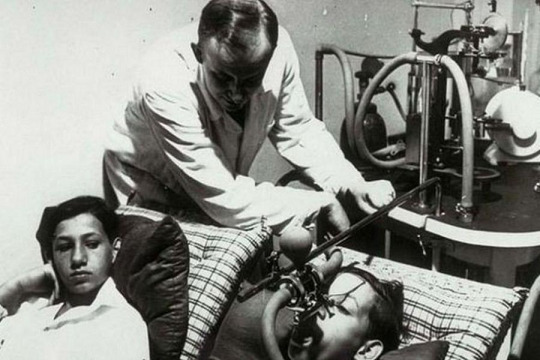
Through his job, he got to see Dr Josef Mengele selecting his ‘patients’ on who he would perform unnecessary surgery, inhumane experiments and amputations, most often resulting in death. He often told Lale: ‘one day, tetovierer, one day I will take you.’ Lale deeply resented Mengele, who would evade prosecution for his war crimes by escaping to South America, later dying of a stroke while swimming.
Eventually, Lale got caught trading jewels for contraband, he was interrogated and beaten. The man who had to torture him was actually a fellow prisoner, and one he knew. He wasn’t able to do it however Lale told him he has no choice. Although he was tortured for a very long time, he never gave up any of the names of people who had given him jewels, or the ones he traded with.
After he was let go, he went to find Gita. She thought he had been killed after he disappeared. He then promised her that one day they’ll get out, get married, have a happy life and that he will ‘fatten her up’ once they got out.
Just two days before the Russian army advanced on Auschwitz, Gita was selected to leave the death camp. In the 3 years she was in the camp, she kept her surname a secret from Lale, largely because of her lack of hope of getting out. It was said that once they get out, she would tell him her surname. She shouted out her surname to Lale as they took her away and that is when Lale got to know the name of the woman he was in love with – Gita Fuhrmannova. Lale was then taken to Mauthausen camp, which he later escaped and set out to find Gita, only knowing her name but not where she came from.
He discovered that his childhood home still belonged to his family and that his sister Goldie has survived.
Bratislava was the entry point for many survivors returning home to Czechoslovakia, so in a horse cart, Lale went there and waited for weeks at the railway station. The stationmaster then advised him to go to the Red Cross instead.
On his way there, a woman stepped into the street in front of his horse. Gita and Lale found each other.
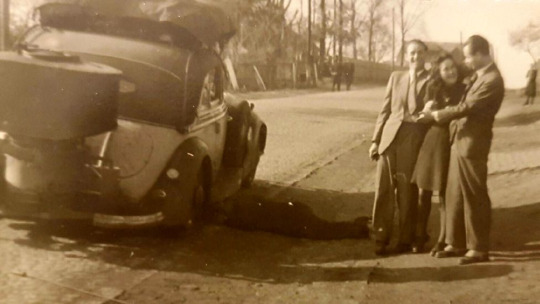
The couple got married, as promised by Lale, in October 1945 and changed their name to Sokolov to fit in better in the then Soviet- controlled Czechoslovakia. They had set up a successful textile shop and had been sending money over to support a movement for an Israeli state. Upon finding out, the government arrested and imprisoned Lale and nationalized their business.
Later they escaped from Czechoslovakia and went to Vienna, then Paris, and then set sail to Sydney as they wanted to get as far away from Europe as they could. On their way there, they met with a couple from Melbourne and decided to move there instead. In Melbourne they started a textile business again, Gita started designing dresses. Gita visited Europe a few times, but Lale never returned.
In 1961, they had a son who they named Gary.
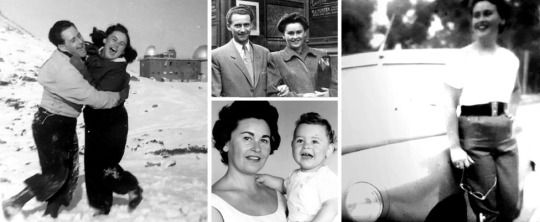
They never told the full extend of the horrors they went though but made him watch The World at War, a show they couldn’t watch.
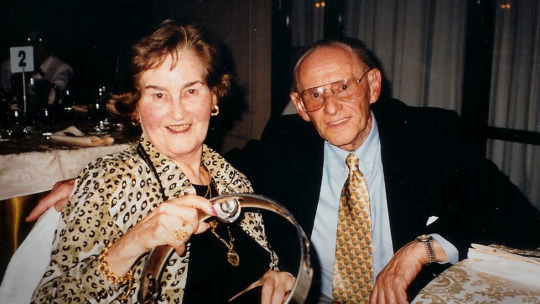
In 2003, following Gita’s death, Lele got in touch with Heather Morris with the aim to tell his story so it would never be repeated. He would tell her about his and Gita’s life and would piece everything together and combine it with her own research into the book The Tattooist of Auschwitz. The book became a best-seller.

#lalesolokov#gitafurman#gitafuhrmannova#theholocaust#drmengele#the tattooist of auschwitz#auschwitz#heather morris#holocaust survivor#history#historyblr#shortbio#short biography#holocaust rememberance day#27 january 2019#birkenau#concentrationcamp
3 notes
·
View notes
Text
15 Excellent Indigenous Art Centres To Support And Celebrate!
15 Excellent Indigenous Art Centres To Support And Celebrate!
Indigenous Art
by Sally Tabart
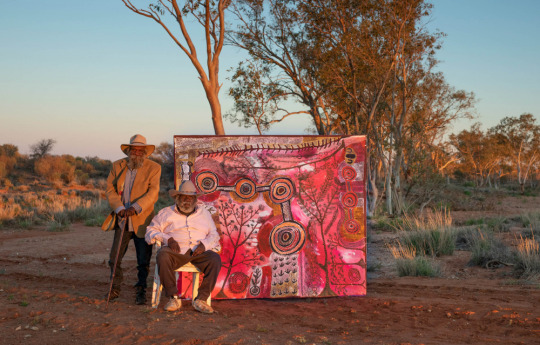
Peter Mungkuri and Alec Baker with their collaborative painting ‘Nganampa Ngura (Our Country)’ (2020) Photo – Meg Hansen, Courtesy of Iwantja Arts.
It’s important to know that Aboriginal artists and art centres are not all one homogenous group – each have their own style, stories, methods, materials and traditions that are unique to their Country and culture, that often cannot be practiced elsewhere. Through the artwork produced in community art centres there is so much to be learned about the spirit, culture and history of our country’s First Nations people.
There are a few things to keep in mind when purchasing artwork by Indigenous artists. Supporting art centres that are Aboriginal owned, operated and governed means that economic autonomy remains within the community. I asked Shilo McNamee, Darwin Aboriginal Art Fair Foundation’s (DAAF Foundation) artistic director, why this is important.
‘Art Centres are the beating heart of Indigenous communities. Supporting art centres ensures that Australia’s Indigenous art sector continues to flourish and excel’, she says. ‘The economic independence of communities helps ensure that people can continue to live on their homelands, resulting in the preservation of traditional practices, ceremonies, language, art and spirituality.’
Another important thing to look out for is that the art centre (or anywhere you are purchasing Aboriginal artwork from!) is a signatory of the Indigenous Art Code (IartC). This is a code of conduct (the Code) that art dealers, art centres and galleries can join to demonstrate their commitment to fair and ethical dealings when working with Indigenous artists. When art centres become signatories of the IartC, they are considered Dealer Members. ‘These businesses are committed to the fair and ethical trade with Aboriginal and Torres Strait Islander artists, and transparency in the promotion or sale of artwork’, says Gabrielle Sullivan, CEO of the Indigenous Art Code. ‘Dealer Memberships signifies a commitment to act fairly, honestly, professionally and in good conscience in all direct or indirect dealings with artists.’ Members of the IartC will generally display a logo on their website. You can read more about the IartC’s recommendations for buying ethically here.
As far as what percentage of an artwork purchase goes directly back to the artists, DAAF’s Executive Director Claire Summers notes an industry standard as guideline. ‘Art centres have systems in place to ensure artists are paid ethically. It is an industry standard for artists to receive 60 per cent of the sale price, with 40 per cent returning to the Art Centres, to continue their important work in the community’, she says.
You should also expect to receive a Certificate of Authenticity (CoA) with artwork purchases over $250.
Now you’re equipped with the information to make an ethical purchase from an art centre – WHERE TO START? Many art centres have great websites and Instagram pages where you can learn more about the artists, their Country and their practice, and shop their artwork online. The Darwin Aboriginal Art Fair – who return 100% of all sales directly to the participating artists and art centres – has recently announced they will be going online this year from August 6th – 11th (check out their list of all 75 participating art centres and register for early access here), and the annual Tarnanthi Festival in South Australia has a great online portal for navigating their Art Fair’s participating art centres here.
To get you going, we’ve put together a list of 15 art centres that are Aboriginal owned and operated, signatories of the Indigenous Art Code, and showcase a diverse range of the incredible work being produced by artists of the world’s oldest living culture.
Please note this is by no means an exhaustive list – according to the IartC, there are over 60 Aboriginal and/or Torres Strait Islander-owned art centres who are members of the IartC! This is a place to start – we encourage you to keep looking, learning, supporting and celebrating!

Left: Betty Muffler with her painting ‘Ngangkari Ngura’ (2020). Right: Eric Barney with his painting ‘Ngura (Country)’ (2020). Photo – Meg Hansen, Courtesy of Iwantja Arts.

Tiger Yaltangki with his painting ‘Self Portrait’ (2020). Photo – Meg Hansen, Courtesy of Iwantja Arts.
Iwantja Arts
Iwantja Arts is located in the rocky, desert country of Indulkana Community on the Anangu Pitjantjatjara Yankunytjatjara (APY) Lands in the remote north-west of South Australia. Founded in the 1980s by respected Anangu artists and community leaders Alec Baker and Sadie Singer, Iwantja Arts now supports the artistic careers of over 40 predominantly Yankunytjatjara artist members, providing access to artistic and professional development.
Many renowned artists have been nurtured and supported at Iwantja Arts, including Sulman Prize-winning Kaylene Whiskey and Vincent Namatjira, who became the first Aboriginal artist to win the Archibald Prize in 2020.
Artist Vicki Cullinan says, ‘The Iwantja art centre is the most important place in our community. It’s a place where everyone comes together, young and old. It’s really special. Families are working together. A lot of times people are singing inma (cultural songs) while they work. Iwantja Arts is a place where people can work to make money for their families. Everyone needs a job and working as artists means that we are also keeping our culture strong and passing on important knowledge to the next generations.’
Visit the Iwantja Arts online store here and follow them on Instagram here.

Left: ‘Iwantja Tjukitji (Iwantja Soakage)’ by Julie Yatjitja of Iwantja Arts. Right: Leah Brady, at the APY Studio in Adelaide.

Left: Nyunmiti Burton in front of her painting at APY Gallery Adelaide. Right: ‘Kapi Tjukula’ by Yaritji Heffernan.
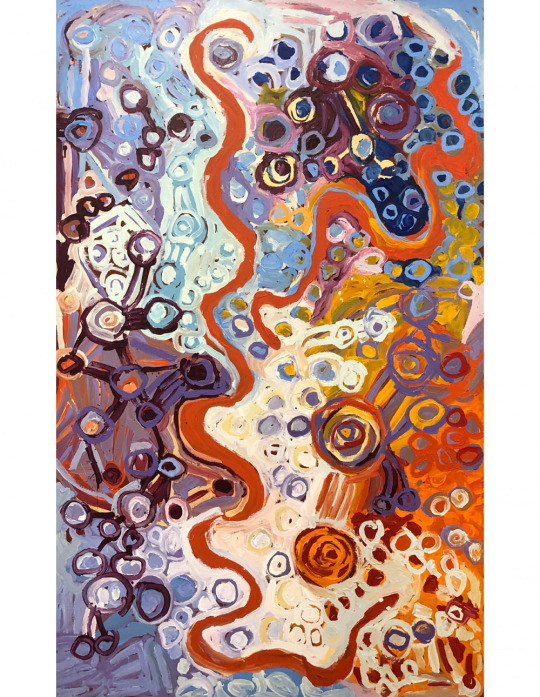
‘Wanampi Tjukurpa’ by Kukika Adamson.
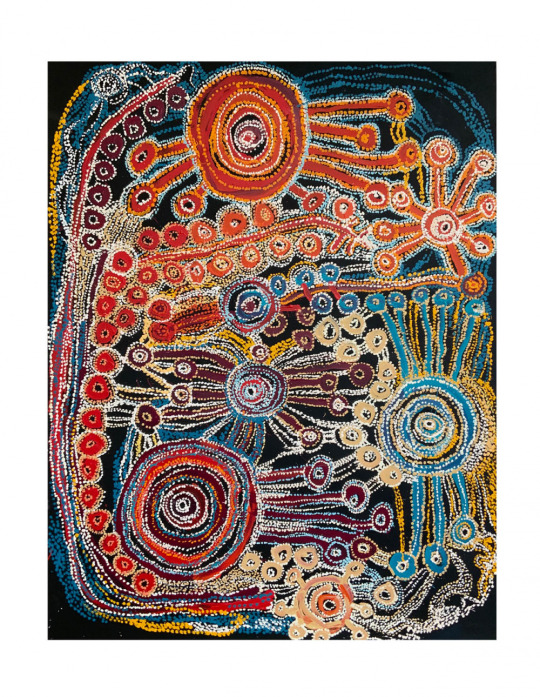
Artwork by Sharon Adamson of Tjala Arts.
APY Gallery
The Anangu Pitjantjatjara Yankunytjatjar (APY) Centre Collective is a group of 11 Indigenous owned and governed enterprises. The APY Galleries in Adelaide and Sydney are run by APY Art Centre Collective, creating a platform to exhibit and celebrate the work of young and emerging APY Artists.
The Anangu Pitjantjatjara Yankunytjatjara Lands (APY Lands) are located in remote Central Australia. The galleries represents the work of seven art centres – Mimili Maku Arts, Tjungu Palya, Ninuku Arts, Tjala Arts, Iwantja Arts, Kaltjiti Arts, and the Tjanpi Desert Weavers – facilitating sales and marketing the work of over 500 Indigenous artists. APY Art Centres are powerful places, and vital to the community.
The APY Galleries showcases artists working across a wide range of mediums from painting, traditional punu (wood) carving, weaving, textiles, new media and digital photography. These emerging young artists have watched, listened and learned from their grandparents, the senior men and women of the APY Lands.
Visit the APY Gallery online store here and follow them on Instagram here.

Epic woven hat by Doreen Djorlom of Marrawuddi Art Centre. Photo – courtesy of Marrawuddi Art Centre.

Weaving by Melba Gunjarrwanga of Marrawuddi Art Centre. Photo – Marrawuddi Art Centre.

Amy Namarnyilk and her partner Rodney, with Amy’s incredible weavings! All hand woven with pandanus, which have been collected and dyed with natural dyes. Photo – courtesy of Marrawuddi Art Centre.

Patsy Kelly and her sensational Marebu! Photo – courtesy of Marrawuddi Art Centre.

Painting by Robert Namarnyilk of Marrawuddi Art Centre.
Marrawuddi Arts Centre
Marrawuddi Arts & Culture is located in the heart of the Kakadu National Park and works with over 400 artists from the Kakadu and West Arnhem region. Marrawuddi is a vibrant community hub providing working space for artists, stunning artworks for tourists to view and purchase and excellent coffee for everyone. Recently relocated to a stunningly renovated space right in the town of Jabiru, Marrawuddi is the first business to secure a lease under the post-mining plans for of Jabiru. The town was handed back to the Mirarr traditional owners in June 2021 as part of the long-awaited transition away from imposed uranium mining.
Artists at Marrawuddi practice painting methods that draw on traditions used for thousands of years. Using manyilk (sedge grass) and ochre, artists create patterns called rarrk, commonly known as cross hatching. Contemporary art methods such as screen printing and fine art painting are also practiced here, and the daluk (women) of Kakadu and West Arnhem also create incredible pandanus fibre art. Alycia Marrday of Marrawuddi Arts & Culture is a finalist in the Handcrafted category of the 2021 TDF Design Awards!
Marrawuddi is owned and controlled by the Mirarr clan through their representative organisation the Gundjeihmi Aboriginal Corporation (GAC).
Mirrar Traditional Owner Simon Mudjandi said at the opening of Marrawuddi’s bright new location in 2020, ‘Today is the start of a new and exciting chapter for Jabiru and Kakadu. With the opening of the new Marrawuddi Arts Centre, Jabiru’s transition from mining town to an Aboriginal owned community centre and tourism hub really begins.’
Visit the Marrawuddi online store here and follow them on Instagram here.

Artwork by Gwenneth Blitner of Ngukurr Arts. Image – courtesy of Ngurkurr Arts.
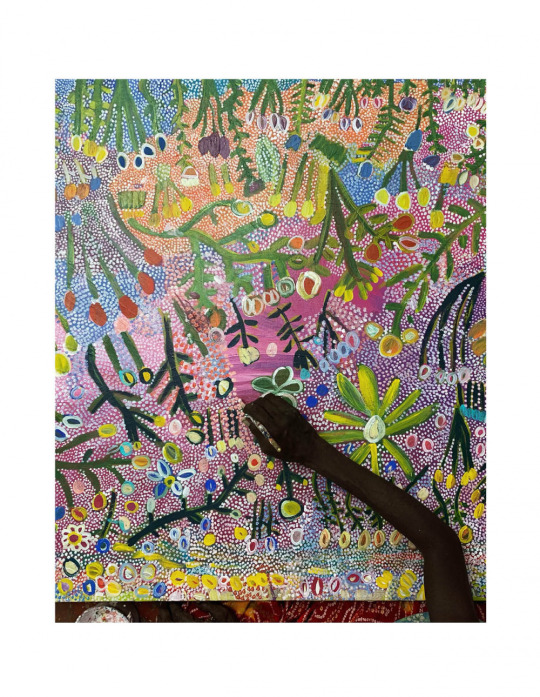
Gwenneth Blitner at work! Photo – courtesy of Ngukurr Arts.

‘Crayfish’ by Wally Wilfred Ḏakawa of Ngukurr Arts. Image – courtesy of Ngurkurr Arts.
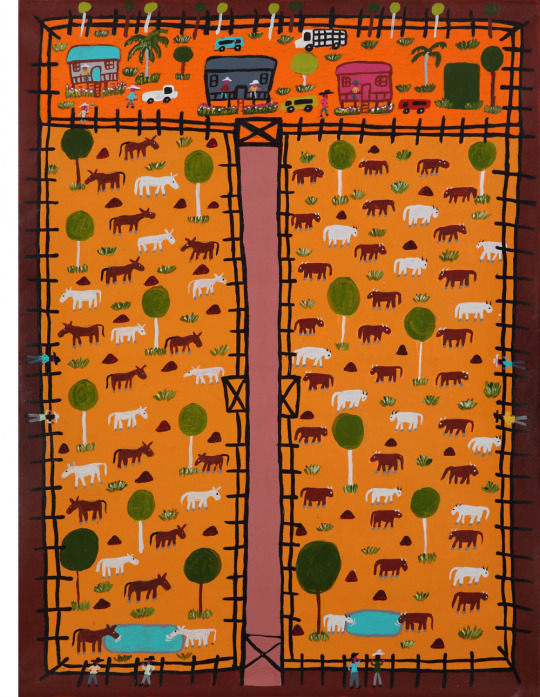
‘Station Life’ by Jill Daniels of Ngukurr Arts. Image – courtesy of Ngurkurr Arts.
Ngukurr Arts
Ngukurr Art Centre is positioned by the banks of Roper River, at the south-eastern most cusp of Arnhem Land. The Art Centre, much like Ngukurr (which means ‘place of many stories’), is abundant with diverse histories, traditions and stories – bringing together many different clans and language groups. The community is home to Ngalakgan, Alawa, Mangarrayi, Ngandi, Marra, Warndarrang, Nunggubuyu, Ritharrngu-Wägilak and Rembarrnga, known collectively as Yugul Mangi (meaning ‘all of us together’). Here, the artists draw from personal history, cultural memory, Ancestral knowledge, ceremonial responsibilities and varied artistic influences, experimenting with colour, form and representation.
‘Melabat plenti langgus mob bat melabat bin migim wan pipurl. Dismob ting migim melabat strongbala,’ says senior culture man 78-year-old Walter Kolbong Rogers. Translating from Roper Kriol he says: ‘We are many language groups, but we came together and now we are one people. This art makes us strong.’
Visit the Ngukurr Arts online store here and follow them on Instagram here.
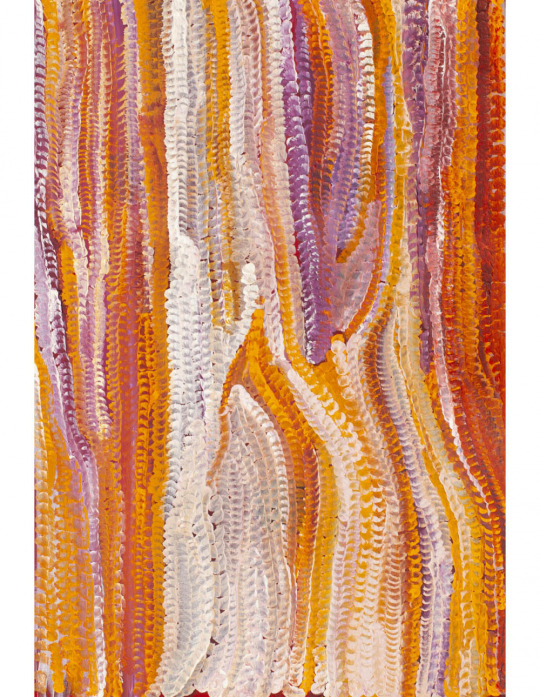
‘Wantili’ by Cyril Whyoulter of Martumili Artists. Image – courtesy of Martumili Artists.

‘Parnngurr Community’ by Bugai Whyoulter of Martumili Artists. Image – courtesy of Martumili Artists.

Martumili artists Elizabeth Toby and Lorna Linmurra. Photo – Kate Shanasy.

Left: Martumili artists painting at the art centre. Right: Artist Judith Anya Samson. Photo – Kate Shanasy.

From Left to right: ‘Untitled’ by Ivy Bidu, Untitled by Bugai Whyoulter, Nyurnma by Muuki Taylor of Martumili Artists. Images – courtesy of Martumili Artists.
Martumili Artists
Martumili Artists was established by Martu people living in the communities of Parnpajinya (Newman), Jigalong, Parnngurr, Punmu, Kunawarritji, Irrungadji and Warralong. The artists and their families are the traditional custodians of vast stretches of the Great Sandy, Little Sandy and Gibson Deserts as well as the Karlamilyi (Rudall River) area.
Bright, bold and expressive art making represents the exuberant personalities of the Martu people.
Younger Martu artists typically begin painting with their parents, grandparents and extended family, fostering an organic process of learning – not only about painting techniques, but also specific locations, family histories, traditional ways of life, bush tucker and Jukurrpa (Dreaming).
In this year’s Vivid festival in Sydney (postponed to September this year), eight Martumili artists will have their work light up the sails of the Sydney Opera House, bringing to life their 2013 collaborative artwork ‘Yarrkalpa (Hunting Ground), Parnngurr Area’!
Artist Corban Clause Williams of Martumili talks of the transfer of cultural knowledge from senior Martu artists to the younger generation: ‘The old people, they sit down and paint and tell stories of the old days, and we listen and learn.’
Visit the Martumili online store here and follow them on Instagram here.

Pirrnpirrnga – Desert Bore by Ann Lane Nee Dixon of Ikuntji Artists. Photo – courtesy of Ikuntji Artists.
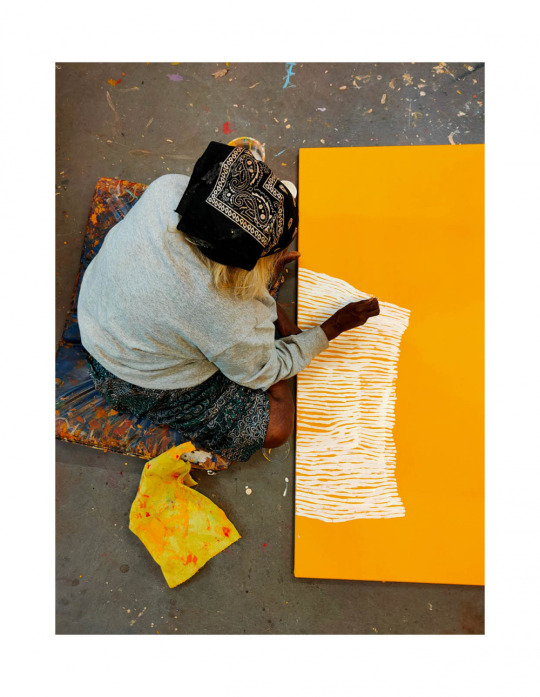
Artist Eunice Napanangka Jack working on a painting for a show. Photo – courtesy of Inkuntji Artists.

An Ikuntji artist working. Photo – courtesy of Inkuntji Artists.

Sheraldeen Marshall modelling pieces from the beautiful Inkuntji Artists x Publisher Textile collection! Photo – Christian Koch
Ikuntji Artists
Founded in 1992, Ikuntji Artists was the first art centre established by women in the Western Desert Art Movement.
Situated in the community of Haasts Bluff (Ikuntji) in Central Australia, which has a population of around 150 people, Inkuntji Artists has a board of seven Indigenous directors all of whom live and work locally.
Known also for their textile designs, recently Inkuntji have collaborated with Publisher Textiles on a clothing collection featuring the bold textile designs by artists Keturah Zimran, Mavis Nampitjinpa Marks, Eunice Napanangka Jack, Lisa Multa and Leonie Kamutu the collection shortlisted in the Textile Design category for the TDF Design Awards!
Artist and textile designer Keturah Zimran says, ‘I feel really proud of myself and my kids, seeing the paintings on the clothes. My dream is to keep doing the paintings, to keep going..… so I can teach my grandkids.’
Visit the Inkuntji Artists online store here and follow them on Instagram here.
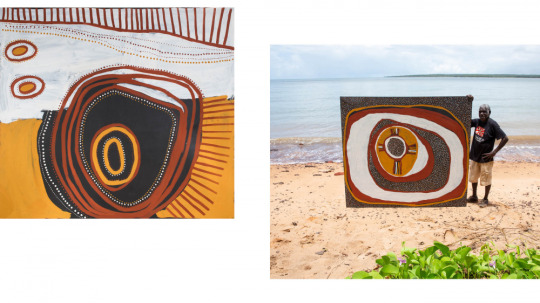
Left: Ngiya Murrakupupuni by Dino Wilson of Jilamara Arts. Right: Timothy Cook with his painting Kulama and his Country Mananowmi in the distance, 2021. Photo – Will Heatcote for Jilamara Arts
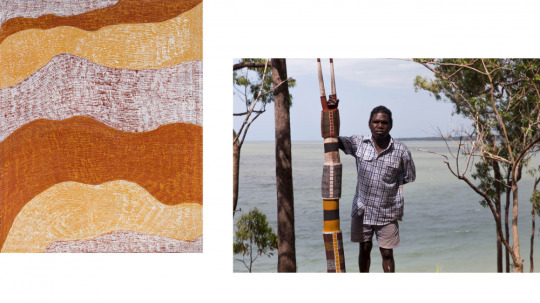
Left: Ngiya Murrakupupuni by Michelle Woody Minnapinni of Jilamara Arts. Right: Pedro Wonaeamirri with his Tutini for NIRIN BoS, 2020. Photo – Will Heathcote for Jilamara Arts
Jilamara Arts + Crafts Association
Located in the community of Milikapiti on the north coast of Melville Island (off the coast of the Northern Territory), Jilamara Arts + Crafts Assoication represents Tiwi art from up to 60 local artists. Established in 1989, they are highly respected for work based on jilamara (body paint design), Tiwi creation stories and unique island ceremonies such as Kulama and Pukumani.
The Tiwi Islands have been separated from mainland Australia for at least 3000 years, leading to the development of regionally distinct creative practices.
Jilamara Arts and Crafts is fully owned and governed by Tiwi artists from the Milikapiti community, led by an Executive Committee of nine elected Tiwi directors.
‘We live on a remote community. It is time for us to be seen and heard. We want people to recognise how strong our culture is. Glimpse how beautiful and complex our culture is, our families, our counties, our history, our future. We adapt, we evolve, we change, we create as we write into the future’, says artist Colin Heenan-Puruntatameri.
Visit the Jilamara online store here and follow them on Instagram here.

Left: Weaving by Evonne Munuyngu of Bula’bula Arts. Right: Banda (Long Neck) by Roy Burnyila of Bula’bula Arts
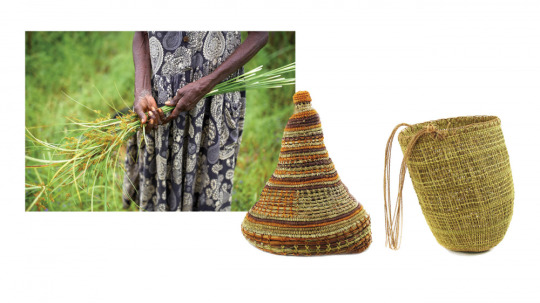
Left to right: Collecting for weaving, Weavings by Janice Djupuduwuy and Julie Djulibing Malibirr of Bula’bula Arts.
Bula’bula Arts
Based in the Yolgnu community of Ramingining in central Arnhem land, Bula’bula is an arts centre supporting 150 artists from the town and surrounding art stations. The centre’s online store sells bark and canvas paintings depicting stories of Yolgnu culture in ochre, white clay and charcoal; as well as weavings and fibre art woven from locally harvested materials such as pandanus, sand palm and kurrajong bark stained with natural dyes made from fruits, roots and leaves.
Visit the Bula’Bula Arts online store here and follow them on Instagram here.

Artwork by Johnny Warrkatja Gapuwiyak Culture and Arts. Image – courtesy of Gapuwiyak Culture and Arts.
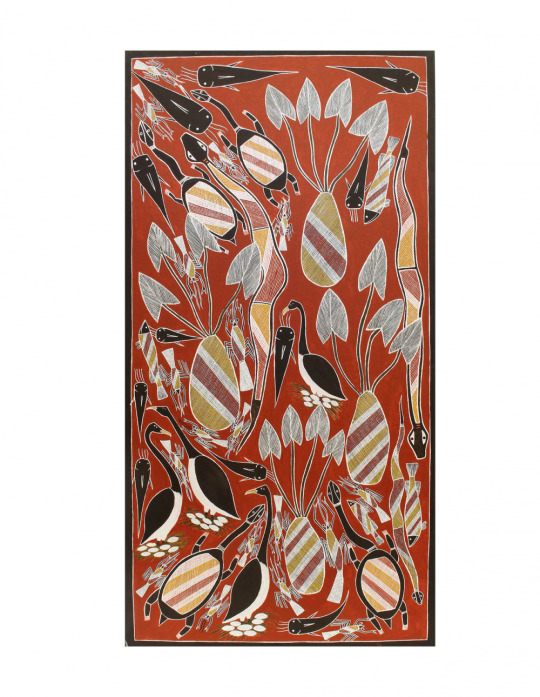
Artwork by Johnny Warrkatja of Gapuwiyak Culture and Arts. Image – courtesy of Gapuwiyak Culture and Arts.
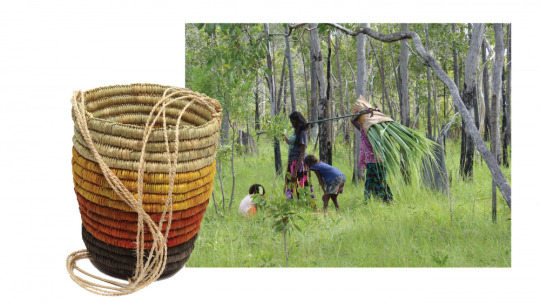
Gapuwiyak Culture And Arts
Gapuwiyak Culture and Arts is a remote Art Centre in east Arnhemland. There are eighteen clans in this region, each with their own interconnected clan estates, songs, patterns and designs.
The Art Centre is owned by Yolŋu members, have a Yolŋu Board, and employ a manager and arts workers, and supports over 100 artists from Gapuwiyak and surrounding homelands.
Artist Jason Marrkula is a Traditional Owner for the Gapuwiyak tribe and says ‘I like to share my culture with people through my art or by taking them to my land. I share my dreams, my stories with my mind and with my heart so people can learn about the land, the birds, the nature and our culture. This is really important for me.’
Visit the Gapuwiyak online store here and follow them on Instagram here.
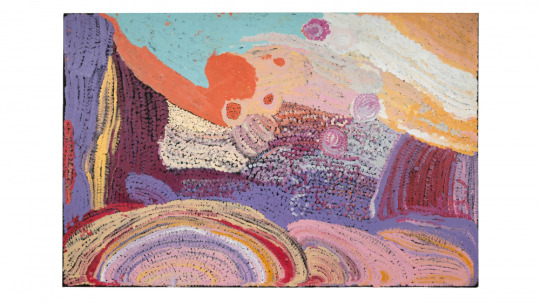
‘Untitled’ by Mulyatingki Marney and Nancy Nyanjilpayi of Spinifex Hill Artists.

‘Untitled’ by Nyangulya Katie Nalgood of Spinifex Hill Studio.

‘Wantili’ by Country Ngamaru Ngamaru Bidu of Spinifex Hill Studio.
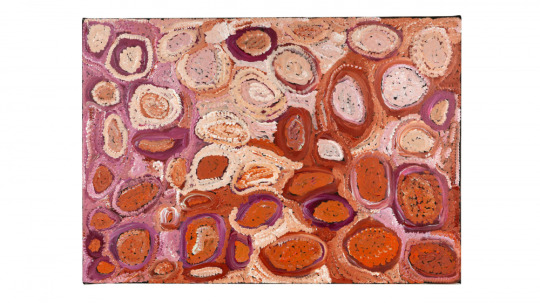
‘Jarntinti’ by Nyanglpayi Nancy Chapman of Spinifex Hill Studio.

Left: ‘Untitled’ by Doreen Chapman of Spinifex Hill Studio. Right: ‘Untitled’ by Selena Brown of Spinifex Hill Studio.
Spinifex Hill
Spinifex Hill Studio stands on Kariyarra Country in the Pilbara region of Western Australia. It is home to one of the youngest Aboriginal art collectives in the north-west of Australia, Spinifex Hill Artists.
Over 100 emerging, mid-career and established artists make regular use of the Studio facilities, with a primary focus on contemporary acrylic painting in bright, confident colours. These are artists from many different language groups, including Kariyarra, Banyjima, Mangala, Manyjiljarra, Martu, Noongar, Nyangumarta, Nyamal, Nyiyarparli, Walmajarri, Warnman, Yamatji, Yindjibarndi.
Spinifex Hill differs from others in this list in that it is managed by FORM, a Western Australian non-profit cultural organisation. The Studio, the Spinifex Hill Artists, and FORM’s Pilbara-programming is supported through a long-term partnership between FORM and BHP.
After 8 months in construction, Spinifex Hill has just celebrated the opening of a brand new, beautiful Project Space with a new group exhibition, Where We Go to Paint (you can view the catalogue here).
Spinifex Hill Artist Maggie Green (stay tuned for our TDF Collect exhibition with Maggie later this year!) says, ‘We do painting good here. Everyone coming here for painting.’
Visit the Spinifex Hill online store here and follow them on Instagram here.
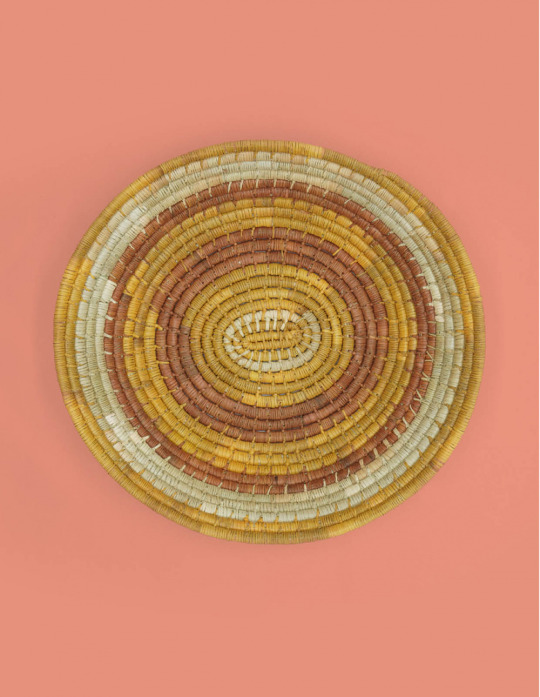
A woven piece by Numbulwar Numburindi artists. Photo – courtesy of Numbulwar Numburindi.

A woven piece by Numbulwar Numburindi artists. Photo – courtesy of Numbulwar Numburindi.
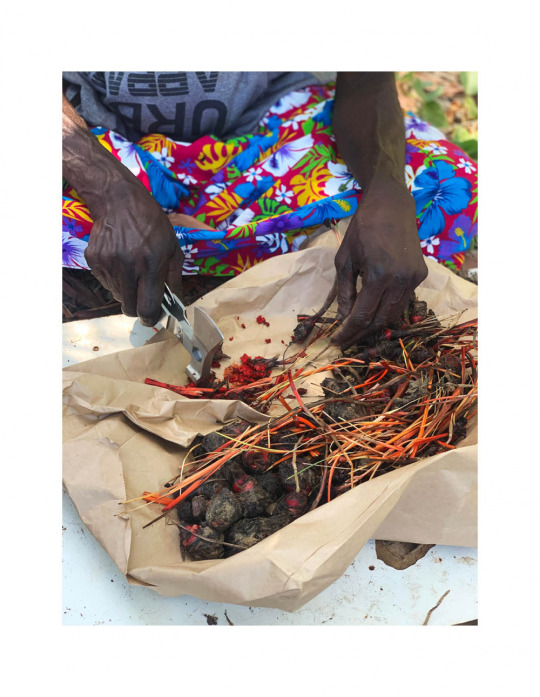
Photo – courtesy of Numbulwar Numburindi artists.
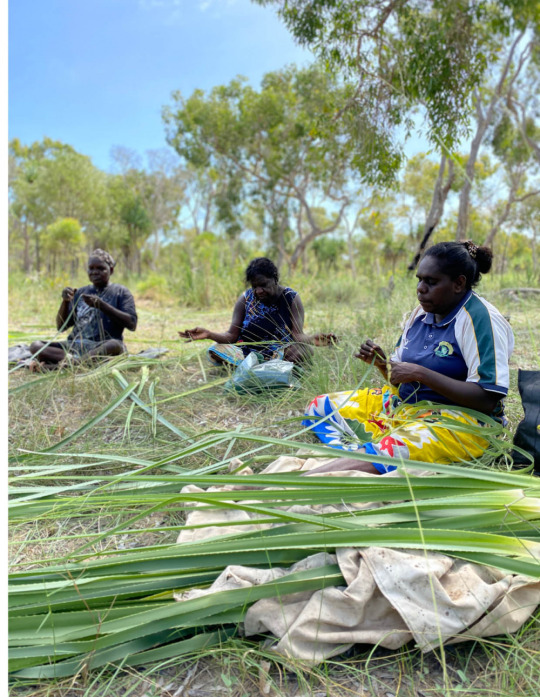
Ladies with pandanus. Photo – courtesy of Numbulwar Numburindi artists.

Woven pieces by Numbulwar Numburindi artists. Photo – courtesy of Numbulwar Numburindi.
Numbulwar Numburindi Arts
Numbulwar Numburindi Arts (NNA) was established in 2019, and is Numbulwar’s first art centre. It is Located on the Rose River on the western coast of the Gulf of Carpentaria (Northern Territory).
Here, artists combine naturally-dyed and locally-harvested pandanus with bright and bold ghost nets, abandoned fishing nets retrieved from Numbulwar’s shorelines. By harvesting ghost nets, the artists perform a modern act of caring for Country, and use the found materials to create intricate wulbung (baskets) and yir (dilly bags).
NNA IS 100% owned and and controlled by the Numburindi people, and employs Numburindi arts workers in the daily running of the Centre
Artist Lillian Joshua explains a little more of the collection of the nets used in NNA works: ‘My son is a sea ranger. He picks the ghost nets up and brings them to the old ladies to use with their weaving, saving marine life, as they are dangerous for animals like turtles and seals.’
Visit the Numbulwar Numburindi Arts online store here and follow them on Instagram here.
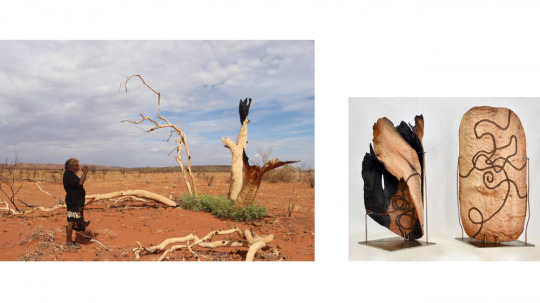
Left: Cynthia Burke on Country, Right: Artwork by Cynthia Burke of Maruku Arts.

Artwork by Niningka Lewis of Maruku Arts.
Maruku Arts
For 35 years Maruku has operated as a not-for-profit art and craft corporation across 22 communities in the NPY Lands, serving more than 500 artists. They are 100% owned by Anangu (Aboriginal people of the Pitjantjatjara, Yankunytjatjara and Ngaanyatjara language groups). Maruku Arts is the only organisation concentrating on punu (wood carving) in the Central and Western Desert area.
Maruku, literally means “belonging to black”, today is one of the largest and most successful indigenous owned and operated organisations.
Located at the Mutitjulu Community within the Uluru – Kata Tjuta National Park, it services all the APY Lands communities, the Pitjantjara NT communities, and the Ngaanyatjara communities in Western Australia.
Maruku’s purpose is to keep culture strong and alive for future generations and to make culture accessible in an authentic and enduring way.
Currently, Maruku comprises of a warehouse based in Mutitjulu community and a retail gallery at Uluru-Kata Tjuta National Park Cultural Centre. Additional to the retail arm, Maruku offers tours, workshops, demonstrations, traditional ceremonies and exhibitions.
Visit the Maruku online store here and follow them on Instagram here.

Nora Abbott in the studio. Photo – courtesy of Tangentyere Artists.

‘Tempe Down, That Country and the Animal that Belong’ by Marjorie ‘Nunga’ Williams, 2020. Image – courtesy of the artist and Tangentyere Artists.

‘When I was Young One’ by Grace Robinya, 2021. Image – courtesy of the artist and Tangentyere Artists.
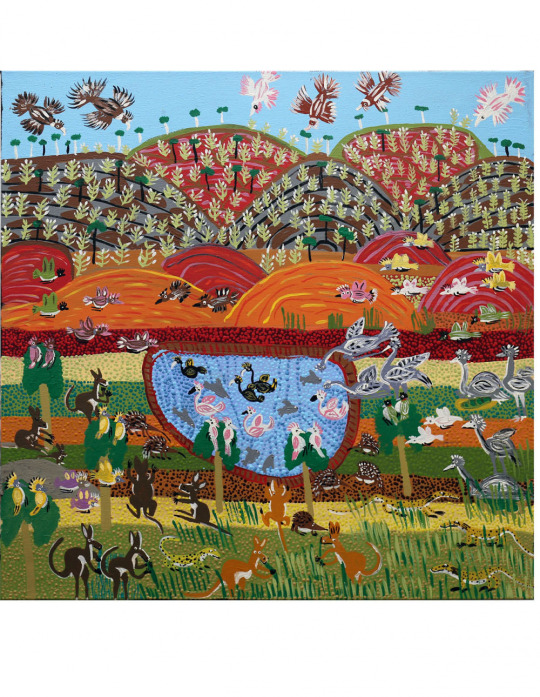
‘Waterhole inside Palm Valley’ by Joanne Napangardi Wheeler, 2021. Image – courtesy of the artist and Tangentyere Artists

‘Big Puta Puta After Rain’ by Nora Abbott, 2021. Image – courtesy of the artist and Tangentyere Artists
Tangentyere Art Centre
Established in 2005, Tangentyere Artists is an Aboriginal owned and run not-for-profit Art Centre in Mparntwe (Alice Springs). Tangentyere is an Arrernte word that means coming together, working together – which is exactly what they do.
Town Camp Artists communicate stories about their families, identity and lives in their artworks, and their practice aims to highlight the everyday experience of Aboriginal people in Central Australia. They are a hub for art activities across the 18 Town Camps of Mparntwe (Alice Springs), supporting emerging and established Town Camp artists through their studio, outreach program, gallery and online store
Artist April Spencer Napaltjarri says, ‘I love painting, telling stories with friends and family. I love coming here to Tangentyere Art Centre for a day of this, tea, people, canvas. Lots of people say hello! Hello! Happy people!’
Visit the Tangentyere Artists online store here and follow them on Instagram here.

Left to right: Tjulpus (birds) by Rochelle Ferguson, Tjilkamarta (echidna) by Lisa Armstrong, Papa (dog) by Katrina Tjitayi of Tjanpi Desert Weavers.
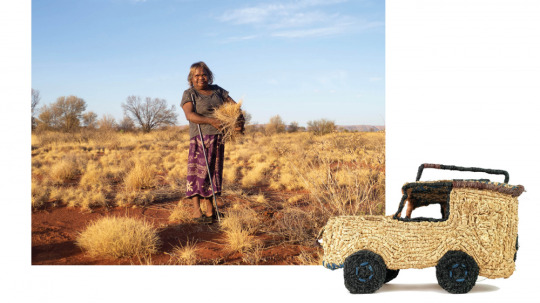
Left: Cynthia Burke from Warakurna (WA), 2019. Image by Jade Brockley Courtesy of Tjanpi Desert Weavers. Right: Umutja Toyota Come on Toyota! by Nellie Patterson of Tjanpi Desert Weavers.
Tjanpi Desert Weavers
Tjanpi Desert Weavers (Tjanpi meaning ‘wild grass’) is an award-winning, Indigenous governed and directed social enterprise of the Ngaanyatjarra, Pitjantjatjara and Yankunytjatjara Women’s Council (NPYWC). They empower over 400 Anangu minyma (Aboriginal women) to earn an income and remain in their communities on Country.
Building upon a long history of using natural fibres to make objects for ceremonial and daily use, Tjanpi artists create vibrant sculptures and baskets using native grasses, wool and raffia. In 2020, Tjanpi senior artist Tjunkaya Tapaya OAM won the Handcrafted Category of the TDF Design Awards!
Fibre artist Nyurpaya Kaika-Burton says, ‘Nowadays there are many different ways in which we transmit those ancient stories because we really hold these stories strong… this sculptural way is a whole new other way… we go out into the country to the actual place where these stories take place, where these dreaming tracks move through the country. We go there and we find materials. These sculptural pieces here are filled up with the story from the land.’
Visit the Tjanpi online store here and follow them on Instagram here.

Left: Nyapanyapa Yunupingu with her family. Right: Artist Nyapanyapa Yunupingu celebrates finishing her huge work Djulpan-Seven Sisters. Photo – courtesy of Buku-Larrŋgay Mulka Centre.
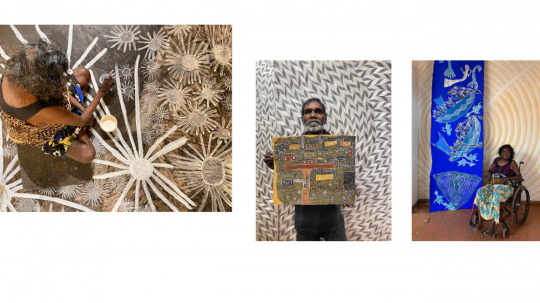
From left to right: Nyapanyapa Yunupingu working on a piece. Wanapa Munuŋgurr with his bark painting depicting his homeland community Wandawuy. Dhambit Munuŋgurr with part of her installation for the NGV Trienniel,
Buku-Larrnggay Mulka
Buku-Larrŋgay Mulka Centre is the Indigenous community controlled art centre of Northeast Arnhem Land. It is located in Yirrkala, a small Aboriginal community on the northeastern tip of the Top End of the Northern Territory, approximately 700km east of Darwin. The art centre has around 20 staff who are primarily Yolŋu, servicing Yirrkala and the approximately twenty-five homeland centres in a 200km radius.
The origins of the Buku-Larrŋgay Mulka Centre can be traced back to the 1960s with renowned artist Narritjin Maymuru, who is counted among the art centre’s main inspirations and founders. Buku-Larrŋgay Mulka Centre consists of two divisions; the Yirrkala Art Centre which represents Yolŋu artists exhibiting and selling contemporary art, and The Mulka Project which acts as a digital production studio and archiving centre incorporating the museum.
Buku-Larrŋgay means, ‘the feeling on your face as it is struck by the first rays of the sun’, and Mulka means, ‘a sacred but public ceremony.’
Visit the Buku-Larrnggay Mulka Centre online store here and follow them on Instagram here.
1 note
·
View note
Text
the government financial aid the woman era 2 piece black short homecoming dressP)(*yujd
Sites To uncover Retro Shoelace Bridal gowns -------------------- Just about every fresh star of the wedding may want to have on an issue that has a resemblance to an issue that the woman mum applied as soon as your lover seemed eveningdoahdkjf to be planning a wedding. This can be a emotion connected with good happiness in addition to suggests all of these women of all ages. Besides manages to do it come to be a component of this loaded heritage, it also enhances the spouse and children prices in addition to ways of life which is to be inherited creation soon after creation. The vast majority of situations, you'll discover the caretaker passing the woman marital life wedding gown to help the woman little princess. There is absolutely no mum that wont think pretty pleased in addition to delighted as soon as your lover perceives her very own very little angel planning a wedding towards male connected with the woman aspirations. In such a circumstance from the similar garments which the mum applied on her behalf wedding ceremony, subsequently absolutely nothing is think it’s great. Even so, there are various functions in the event the bride’s mum are unable to chose the attire of which your lover applied the government financial aid the woman era 2 piece black short homecoming dress. This can be caused by various good reasons including spills, usage or maybe deficit of storage. It is as soon as most of these gals go forth on the lookout for retro shoelace bridal gowns of which has a resemblance to this bygon days to weeks, still will keep in place while using the most current movements. The style marketplace possesses modified during the last few years in addition to there could possibly be some sort of desire for anything a bit trendier. Having custom made dresses in addition to especially designed clothing collection that is certainly manufactured just by most of these exclusive functions, it could possibly receive a very little difficult to acquire this wedding planning costume you generally dreamed of by yourself using. Retro shoelace bridal gowns makes certain that most of these gals uncover anything identical in the event not similar matter them to received as the primary goal as soon as setting up this nuptial wedding service. On the list of selections of which like women of all ages include is usually to visit to some sort of customize and enquire them to develop the item available for you. While many people perform the job properly, the money necessary for this textile in addition to stitches can certainly cost you lots cheap formal dresses sydney.
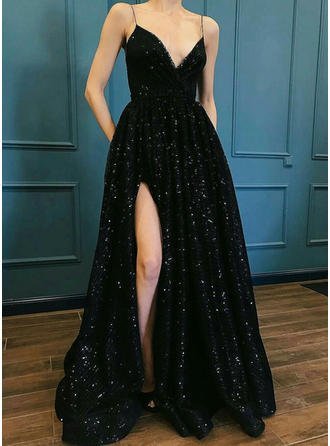
After you approach that wedding ceremony, at this time there is a predetermined funds which the couple of believes to help. When this happens, almost any improvement towards funds could potentially cause considerable complications. The item reasons a asymmetry from the allotment connected with finances intended for other considerations such as gathering, meal along with the wedding band which is to be taking part in. While doing so, there is absolutely no extent for just a skimp on manufactured for this future husband or maybe the girl for being wedded prom dresses 2020 black. Those of you that feel the in their normal soups, you will discover different more cost-effective solutions that you can get. The online world incorporates a current market for virtually every solution. Retro shoelace bridal gowns can be located on like E-commerce internet websites of which are dedicated to attires including lover bridal gowns. As soon as viewing a really web page, you observe a full a number of apparel from which to choose. To be a make any difference connected with actuality, you should be updated while using the very best intended dresses already in the market in addition to for a selling price that is certainly very good black mermaid prom dress. Many people promdresselalashfkw provide you quite a few tasteful morning garments from the measurement in addition to coloration of this decision. Persons include slowly but surely started off migrating to help like one of a kind options for looking the way it facilitates these individuals spend less time period in addition to dollars. If you usually are taking care of an increasingly tasteful look, you can a solution intended for retro shoelace bridal gowns. Dean Sadler would be the article author in this document with. Uncover much more information, in relation to in this article.
Related recommendations:
been in your folk for decades when it comes to the nuptials day short wedding dressesP)(8yghd
there are a sort of celebrations that encounter at the end of the twelvemonth yellow prom dresses POIyughd
the prettify to be too swindle or too agelong with heels on blue off the shoulder prom dressPOIUhd
boys to a higher basic of respecting their individual classmates kohls formal dresses juniors POIuyhj
0 notes
Text
Know my name: The new push for female artists
The push began in March 2016 when the National Museum of Women in the Arts in Washington D.C. launched a social media campaign #Fivewomenartists, asking the public to name five female creators.
The NGA has put its own twist on the campaign and launched #KnowMyName in acknowledgment that only one-quarter of its own collection comprise works by female artists.
''We made the assessment that we need to improve our holdings of women artists,'' said NGA's director Nick Mitzevich. ''We made the decision to do it under scrutiny and to bring everyone with us and, in doing so, encourage other [galleries] to do so, lead a discussion and . . . lead in the representation of women in our holdings, our collection, in our programs. We're doing that because we believe we've not done a good job so far.''
Mitzevich said such poor female representation was not due to the absence of quality female works.

Artists such as Joy Hester deserve to be household names.Credit:ABC
Art history hadn't been ''as inclusive as we want to be right now'' and women weren't given the same opportunities as men to put their work on public display, he said.
Higher status had also been traditionally accorded to painting and sculpture over what has long been regarded as domestic artistic practices such as textiles and printmaking.
Mitzevich points to the contribution of Grace Cossington Smith to Australian art. It went largely unrecognised until 1970 when a retrospective of her work, organised by the NGA's Daniel Thomas, toured Australian galleries.But no rigorous interrogation of Cossington Smith's work would question her innovation or importance, he said.
The gallery is planning a major exhibition of Australian women artists next May. Angelica Mesitis 2019 Venice Biennale work, ASSEMBLY, will be exhibited in March while it has unveiled a new major work by Patricia Piccinini as part of the Balnaves Contemporary Intervention series.
For the first time, the gallery will exclusively show female artists in the 20th century display of Australian contemporary art, jettisoning all male artists in the rehang from May to October 2020.
NGA has kicked off its gender strategy with a social media campaign calling on the public to celebrate the stories of female artists or those in their lives.
It is also looking to partner with an outdoor media advertiser to put the works of female artists on billboards and bus stops in coming months.
Particular prominence is being given to the lives and works of artists Cossington Smith, Joy Hester, Inge King, Yvonne Koolmatrie, Emily Kam Kngwarray, Tracey Moffat, Fiona Foley, Rosalie Gascoigne, Dorrit Black, and Banduk Marika. Their names have been placed on gallery t-shirts.
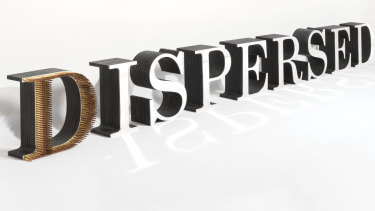
Fiona Foley is a contemporary Australian painter, printmaker, photographer, sculptor and installation artist whose work is greatly influenced by her Badtjala heritage and history.Credit:NGA
Are these figures as important as Nolan, Streeton or Whiteley? ''You bet,'' Wright said. ''They have made, and are making, a major contribution to the cultural life of this country. Yes, they should be household names and we recognise that we have some way to go before they are.''

NGA director Nick Mitzevich: we can do better on female representation.Credit:Dion Georgopoulos
The institutionalised gender imbalance in the Australian arts sector was highlighted in the 2016 Countess Report which found major collecting institutions continued to favour solo exhibitions and the acquisition of new artwork by male artists.

Inge King's 2016 steely contribution to Sculpture by the Sea at Bondi Beach.Credit:Peter Rae
In state museum exhibitions held across Australia in 2014, 34 percent were female artists, 59 percent males, and seven percent collaborations. Commercial galleries showed a 40 to 60 percent split of female to male artists.
In the interest of transparency, the gallery has opened up its database to the report's researchers who are working on a set of industry-wide guidelines with the NGA, NAVA and the Sheila Foundation.
Some names you should know:
Banduk Marika
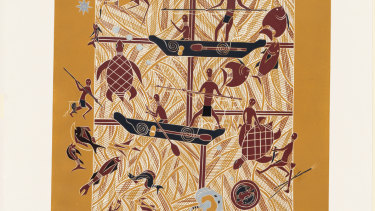
The work of Yolngu printmaker Banduk Marika, from northeast Arnhem LandCredit:NGA
The first Yolngu printmaker from northeast Arnhem Land, Marika uses linoprints and screenprints to depict the ancestral stories from her Riratjingu clan.
Inge King:
A rare woman in a predominantly male field of heavy sculpture, King died in 2016 but her work lives on in the monumental sculptures seen across Melbourne, at the Arts Centre (Forward Surge) and in the grounds of the Heide Museum of Modern Art (Rings of Saturn).
Joy Hester
Part of the Heide circle which included Arthur Boyd, Sidney Nolan, John Perceval and her first husband, Albert Tucker, Hester was known for her psychologically and emotionally charged figure paintings, the most famous being Lovers.
Rosalie Gascoigne

A Rosalie Gascoigne plate.
The first female artist to represent Australia at the Venice Biennale in 1982, her best-known works use domestic items as drinks crates, torn floral lino and enamelware, as well as galvanised tin, corrugated iron, and masonite.
Thea Proctor
An advocate of Australian modernism and a style leader of the late 1920s, the painter, printmaker, designer, and teacher made work with a strong emphasis on structure, style and design.
Linda Morris is an arts and books writer at The Sydney Morning Herald
Most Viewed in Entertainment
Loading
https://www.smh.com.au/entertainment/art-and-design/know-my-name-the-new-push-for-female-artists-20190524-p51qpb.html?ref=rss&utm_medium=rss&utm_source=rss_feed
0 notes
Text
Inside Ross House, a heritage building overflowing with good karma
Posted January 19, 2019 08:00:44

Photo: Ross House was designed by the prestigious Sydney architectural firm Sulman and Power. (ABC Radio Melbourne: Nicole Mills) Related Story: The strangers you can call when loneliness threatens to overwhelm Map: Melbourne 3000
There's a five-storey building in Melbourne's Flinders Lane that's known as Ross House.
You may have seen the 119-year-old red brick tower tucked alongside the city library, close to the cafe-laden laneway of Degraves Street.
It's prime CBD real estate.
But behind the heritage-listed facade is a unique community working to create a better future for society's most marginalised people.
Ross House is the only self-managed and community-owned not-for-profit building in Australia.
There's no landlord. No external owner.
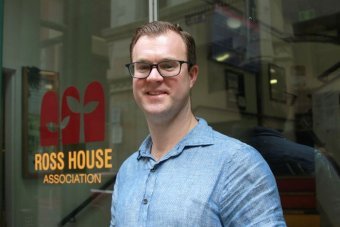
Photo: General manager Michael Griffiths says the members and tenants make up the association. (ABC Radio Melbourne: Nicole Mills)
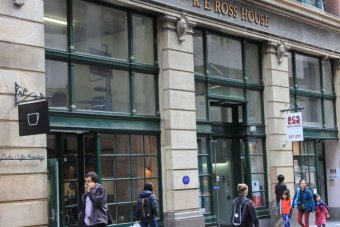
Photo: The building was bought to provide a secure home for small charity and non-profit groups. (ABC Radio Melbourne: Nicole Mills)
General manager Michael Griffiths said it belonged to the community, so they made the rules.
"In essence, the tenants can set their own rent which is why it's so unique," he said.
"Rents are actually on a sliding scale, so we charge people what they can afford rather than what we can make."
A part of Melbourne's history
Ross House was built in 1899 and began its life as a textile warehouse.
It was erected by merchant Sir Frederick Sargood, who commissioned and first lived in the famous Rippon Lea mansion in Elsternwick.
The building, then known as Royston House, was bought by the State Electricity Commission in 1929 and then sold to the RE Ross Trust in 1985.
Ross House Association chair Christine McAuslan, from the Collective of Self Help Groups, said the building's not-for-profit status evolved during a period when community services were fighting for their survival.
"The Victorian Council of Social Services (VCOSS) had a lot to do with setting this up, and a lot of activists were involved back in the '80s," she said.
"There will always be people working towards social equality and overcoming disadvantage."
She said Ross House was not luxurious, but what it lacked in style it made up for in goodwill.
"The work that people do here is fantastic because it takes a lot of commitment and dedication.
"It's not glamourous, we don't have luxurious facilities, but people love being here."
The 55 tenants are made up of disability, environment, health, social justice, multicultural and other groups.
There's a similar number of members who use the facilities on occasion; many of them are on the waiting list for a permanent tenancy.
Were it not for Ross House, many of these groups would likely be run out of people's living rooms or struggle to pay market rent.
But this location, close to public transport and in the heart of the vibrant CBD, allows these small groups to be part of something bigger, all the while secure in the knowledge that the lights won't go out.
Let's meet some of them.
Kate Greenwood, Assisi Aid Projects

Photo: Kate Greenwood says Ross House is full of grassroots organisations. (ABC Radio Melbourne: Nicole Mills)
"We work on community development projects in India and Cambodia with a strong focus on women's empowerment and gender equality projects.
"[One example is] we work with widows and vulnerable women in Tamil Nadu, which is a very conservative area of India.
"Due to widespread alcoholism, lots of men are dying young and there's so many widows being left behind.
"Not only do they find themselves widowed, and then obviously also in poverty because they lose their livelihood, but also they're socially isolated and shunned.
"We do a lot of work with women to bring them together into self-help groups at the village level. Then our partners provide them with skills training and legal literacy so they can actually apply for their widow's pension and the benefits they're entitled to."
Sheryl Forrester, Shine for Kids
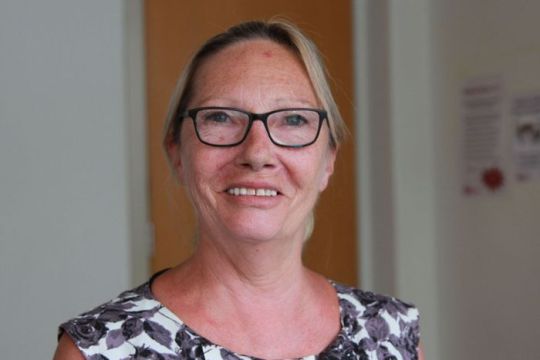
Photo: Sheryl Forrester says children with parents in prison often feel like they're the ones being punished. (ABC Radio Melbourne: Nicole Mills)
"Shine for Kids is the only national organisation that supports children who have parents that are incarcerated.
"We provide supported transport for children to actually visit their parents in prison, we run school holiday camps ... we work in schools, we also run art therapy classes.
"There's so many stories I could tell you about how these children have been involved in the crimes their parents have committed.
"They've seen firsthand the effects of ice and how it destroys a family. They've seen lots of violence.
"They're fairly resilient kids but they really do need someone that they can trust and support and that's what we try and provide for them.
"It's very, very important that we encourage and support these children so that they do not become the next generation of prisoners."
Jane Rosengrave, Reinforce

Photo: Support worker Chris Lowe with Reinforce member Jane Rosengrave. (ABC Radio Melbourne: Nicole Mills)
"Reinforce is a self-advocacy group which is for people with an intellectual disability.
"They have actually been running since the 1980s when the institutions were open. They were telling the government to do the right thing for people with a disability and trying to close those institutions down in those days when they never listened.
"The one thing that I would like to get across to people ... is that us [people with a] disability, we are not a number, we are a person and we have got a strong, powerful self-advocacy and we can stand up for ourselves.
"We've got that voice to be heard and we do not demand and have people talking for us like those olden days ... we do not want to be neglected, we want to be listened to."
Deb Carveth, Community Music Victoria
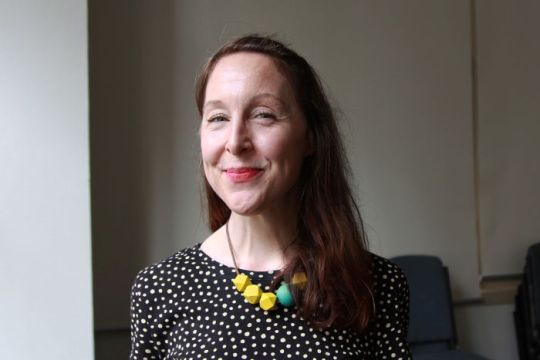
Photo: Deb Carveth believes society is a better place when people make music together. (ABC Radio Melbourne: Nicole Mills)
"Community Music Victoria exists to get music making happening in our communities as a way to bring people together, strengthen the fabric of society and give people an opportunity to explore a side of themselves that we believe everybody should have access to.
"When people make music together magic happens, relationships form, there's cohesion.
"It's incredibly important to us to be part of the Ross House community.
"Everybody here is working towards positive societal change through advocacy, through self-help and it's a great pooling of resources.
"It's really heart-warming to walk through those doors in such a busy, vibrant part of Melbourne and to enter the environment that Ross House supports and enables."
Dabessa Gemelal, Advocacy for Oromia
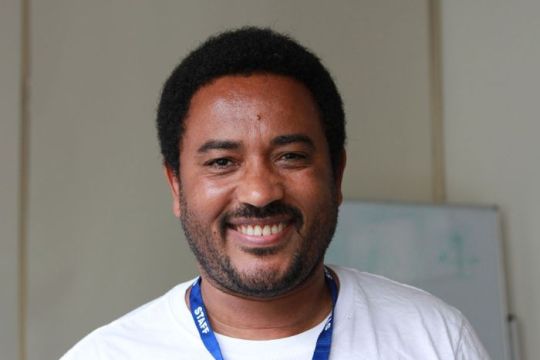
Photo: Dabessa Gemelal says many Oromo fled Ethiopia due to war and political oppression. (ABC Radio Melbourne: Nicole Mills)
"There is Oromo people in Ethiopia who are subjugated for a long time because of their identity. The people came here [to Australia] mainly because of political reasons.
"When people moved from their own land, basically there are a lot of issues: dislocation, identity, family breakdown and trauma from the journeys they came here.
"This group was organised actually to support each other.
"When they come to our office we provide free services in all ranges of community activities.
"Sometimes we organise cultural activities which empower them. It looks like a small [thing] but it is an important ingredient to empower people.
"Ross House is actually good for us ... we are a non-profit organisation based on some small grants from the embassy and members' donations. We don't have enough money to hire a big city office."
Dr Heidi Nicholl, Emerge Australia

Photo: Dr Heidi Nicholl wants more awareness of chronic fatigue syndrome. (ABC Radio Melbourne: Nicole Mills)
"We work with people who have myalgic encephalomyelitis, also known as chronic fatigue syndrome.
"About 25 per cent of people with the condition are so severely unwell that they're housebound or bedbound.
"The stigma for this disease has been very profoundly problematic for this community.
"Historically people have not been believed, they have had problems getting the sympathy they should have, not just from family but from medical professionals.
"There's not enough treatments, and then they haven't really had enough hope that things are actually being researched and that people care enough about this to find therapies or a cure."
Beryl Noonan, Melbourne Osteoporosis Support Group

Photo: Beryl Noonan says the support group helps people better understand their condition. (ABC Radio Melbourne: Nicole Mills)
"Our purpose is to support members who have osteoporosis.
"Osteoporosis causes the bone to become thin, just like a honeycomb.
"Younger people can develop this condition it is not a symptom only of an older person.
"I've got osteoporosis and I've had it for over 20 years. They [the group] do a good job because they give you extra information and give you tips and we have speakers.
"The camaraderie is good."
Topics:community-and-society,charities-and-community-organisations,community-organisations,disabilities,multiculturalism,people,children,family-and-children,women,womens-health,osteoporosis,chronic-fatigue-syndrome,diseases-and-disorders,human-interest,melbourne-3000
http://www.abc.net.au/news/2019-01-19/ross-house-melbourne-a-heritage-listed-non-profit-building/10610824
0 notes
Text
10 Female Designers Shaping the Future of Design
March marks Women’s History Month and International Women’s Day on March 8th, making it the ideal time to share female designers and artists that are breaking molds and shaping the future of the design world. To celebrate, we’re collaborating with the Female Design Council (FDC), an organization founded in 2016 by kinder MODERN founder Lora Appleton, dedicated to supporting female and female-identified persons in the design industry, including over 200 design professionals in the New York City area, as well as a growing community of digital members from around the world. As with most industries, the design world has long been male-dominated but in recent years we’ve started to see the tide (finally!) changing, and it’s a welcome sight. Today, we’re taking a look at 10 of those female designers and artists that are changing the game.
1. Arati Rao \\\ Founder + Designer of Tantuvi
After graduating from Fashion Institute of Technology (BFA in Fashion Design) and Edinburgh College of Art (MA in Fashion), and working as a designer, Arati Rao founded New York-based Tantuvi, a rug and textile design studio launched in 2010 after spending much of that year traveling and researching artisans throughout India. Tantuvi (which means “weaver” in Sanskrit) collaborates with 7th generation dhurrie weavers in North India for their flat weave rugs and Ikat weavers in South India for their textiles, combining fresh, modern takes on traditional patterns and weaves with centuries old techniques, all while working to help provide income for women.
Fragment Rugs \\\ Tantuvi
Circle Rugs \\\ Tantuvi
Photo: Alex Schaefer
2. Kate Casey \\\ Woodworker + Designer of Peg Woodworking
Peg Woodworking landed on our radar in 2015 while on display at BKLYN Designs, and the Brooklyn-based company has had our attention ever since. Kate Casey launched the all-female run operation in 2014 after graduating from Massachusetts College of Art and Design (BFA) and the Yale Norfolk School of Art and moving to Brooklyn in 2009. Years of working as a sculptor led Casey to a form a passion for well-designed objects and a desire to hone her woodworking and design skills, which led to completing an intensive program at the Center for Furniture Craftsmanship. Today, the brand’s catalog of work merges her love of woodworking with other mediums, like weaving, showing her versatility as an artist and designer.
Euclid Shelf \\\ Peg Woodworking
Satet Bench \\\ Peg Woodworking
Photo: Sydney Brown
3. Mary Little
Born in Northern Ireland, artist Mary Little now calls Los Angeles home after landing in the United States in 2001 to start a teaching position at California College of the Arts in San Francisco. Little studied furniture design at London’s Royal College of Art and worked in that field before pivoting towards sculptural work with unbleached artist canvas as the medium of choice. The minimalist material becomes a place where her emotions and memories of childhood are expressed through light and shadow, movement and tranquility, to form unexpected sculptural tapestries.
Whitechurch, 2019. 73” x 80” x 7”, unbleached canvas \\\ Mary Little
Islandmagee triptych, 2018. 40” x 110”, unbleached canvas \\\ Mary Little
4. Molly Fitzpatrick \\\ Founder + Lead Designer of DittoHouse
If you’re familiar with Design Milk, chances are you’ve seen the work of one of our favorite brands, DittoHouse. The textile brand was founded in 2015 by Cleveland-based textile designer Molly Fitzpatrick whose work was, and still is, in high demand in a variety of markets, including home furnishings, major airlines, and baby accessories. Her signature aesthetic is highlighted by graphic patterns and bold color palettes that will leave you smitten with their ability to overhaul and enhance any space. Plus, her commitment to the environment, humanity, and social justice is pretty remarkable. \\\ Shop the DittoHouse collection here!
Step Throw and Block Party Throw \\\ DittoHouse
Lala Throw and Hopeful Pillow Cover \\\ DittoHouse
5. Rosie Li \\\ Founder + Designer of Rosie Li Studio
For Chinese-born American designer Rosie Li, a love of drawing and sculpture led to the Rhode Island School of Design where she graduated with a BFA in Furniture Design in 2011. Fresh out of school, Li partnered with lighting brand Roll & Hill to launch the Op Art-inspired mirror sconce, Stella, which was named after painter Frank Stella. That collaboration set the foundation for her thriving, Brooklyn-based lighting design studio, which specializes in sculptural, geometric lighting inspired by nature.
Custom Bubbly Table Lamp in Rainbow \\\ Rosie Li
INEZ Collection \\\ Rosie Li
6. Maureen Wynne \\\ Founder of Wynne Ware
Native Californian Maureen Wynne is the founder of Wynne Ware, an online shop featuring works that are designer-made and one-of-a-kind. The Los Angeles-based Wynne followed in her parents’ footsteps collecting finds, from art to jukeboxes, that fueled her love of design and craftsmanship. An art history degree from UC Berkeley and career in marketing at Google further honed her artist’s perspective, helping to launch and sustain a company offering a curated mix of works from emerging designers and found vintage wares.
Wavy Vase \\\ Wynne Ware
Blue Bowls \\\ Wynne Ware
Photo: Sophie Mathewson
7. Arielle Assouline-Lichten \\\ Founder of Slash Objects
Perhaps you’re familiar with the Slash Objects brand, but maybe not so familiar with the designer behind it. Arielle Assouline-Lichten earned a Masters of Architecture from Harvard University before going on to work with renowned design firms Bjarke Ingels Ground (BIG), Kengo Kuma, and Snøhetta. The architect and designer launched product brand Slash Objects as an offshoot of her Brooklyn-based design firm, Slash Projects, which she founded in 2013. Her architecture background and fascination with materials drives her work, much of which integrates an industrial material made of post consumer recycled rubber. The unexpected pairing of rubber with brass, marble, and concrete leads to fresh takes on design objects and furniture. \\\ Shop the Slash Objects collection here!
COEXIST Daybed \\\ Slash Objects
Rubber and Brass Baskets \\\ Slash Objects
Photo: Allison Michael Orenstein
8. Liz Collins
Liz Collins is a Brooklyn-based artist whose work teeters between art and design, ranging in scale from small stitched drawings to large-scale installations, and a variety of mediums, including woven textiles, paintings, video, furniture, architectural, and more. Collins’ multidimensional work combines a mix of historical movements – think Op and Pop Art, Arte Povera, and Memphis – and her own queer sensibility, coming through via vibrant color palettes, bold patterns, and energetic textures. With a long list of solo and group exhibitions, and artist residencies already to speak of, the RISD graduate (BFA and MFA) and multi-year Queer|Art Mentor will be presenting new projects this year at The Addison Gallery of American Art in Andover, Massachusetts, and Rossana Orlandi in Milan Italy.
Royal Embrace, 2019 \\\ Liz Collins
Rapture, 2020 \\\ Liz Collins
9. Sara Berks \\\ Founder + Creative Director of MINNA
Textile designer Sara Berks studied graphic design at The School of Visual Arts before launching her contemporary home goods brand in 2013. MINNA, a queer woman-owned and mostly queer or woman-operated business, is made up of a group of seven artists and creators in Hudson, New York, where their brick-and-mortar shop and studio are now located after having launched in Brooklyn. Inspired by Feminist art and the Bauhaus, the textiles company works closely with master artisans in Central and South America, helping to preserve age-old craft techniques while creating necessary jobs in the regions. \\\ Shop the MINNA collection here!
Various pillows and textiles \\\ MINNA
Various rugs \\\ MINNA
10. Michele Quan \\\ Artist of MQuan Studio
Once you’ve seen the work of Michele Quan, artist behind Brooklyn-based MQuan Studio, you’ll never forget the designs featuring bold motifs that give nod to symbols of Eastern iconography. Quan’s ceramic pieces range from wall hangings, hanging bells, candles, incense burners, birdhouses, planters, tabletop, and objects, each made and painted by hand with her instantly recognizable graphics – constellations, rainbow stripes, and black & white shapes – as they become three-dimensional canvases for her “love of drawing, painting, text, and color.”
MQuan Studio Sconce for Allied Maker \\\ Photo: Allied Maker
MQuan Collection for Hilma af Klint at the Guggenheim \\\ Photo: Allison Chipak, courtesy of The Guggenheim Store
Photo: Jenny Siegwart
Bonus: Jaime Derringer \\\ Founder + Executive Editor of Design Milk
We’d be remiss if we didn’t mention Design Milk’s very own founder, Jaime Derringer, who founded this ever-growing, design-loving adventure 13 – 1/2 years ago! Without her, we wouldn’t be here!
From Lora Appleton, Founder of Female Design Council and kinder MODERN:
Design Milk and Jamie Derringer have been an amazing support to Female Design Council from the beginning. Their commitment to highlighting incredible works by women and women-identifying creators provides both aspiring and established designers a way forward in the challenging landscape of design.
\\\\\\
If you’d like to join the Female Design Council, you can check out all of their available memberships here. They have a new digital membership that’s a great option for those not in New York, but would like to receive the online benefits that the FDC offers!
If you want to support some female designers, visit the Design Milk Shop here to see a collection of their available design-driven goods!
via http://design-milk.com/
from WordPress https://connorrenwickblog.wordpress.com/2020/03/03/10-female-designers-shaping-the-future-of-design/
0 notes
Text
Aligning recycling and manufacturing in the COVID era
The UNSW SMaRT (Sustainable Materials Research and Technology) Centre is helping to align recycling and manufacturing in the new COVID-19 era to address the challenges around delivering more sustainable product outcomes.
As organisations and businesses started to experience difficulty in obtaining materials and products for their operations, the notion of ‘sovereign capability’ — where a nation relies more on its own resources and materials — has provided a boost to the sustainability discussion.
Across Australia, what we really need is an alignment of recycling and manufacturing and to start seeing waste as a valuable (and renewable) resource for much of the materials we use in society.
Adopting and operationalising circular economies — where materials are kept in use for as long as possible to create greater sustainability — will really only occur through such an alignment.
One recent example is the SMaRT Centre’s prototyping of frames for face shields for use in medical settings, using filament made from 100% waste plastic using our Microfactorie technology.
A key lesson was how valuable filament — which is mostly only available from overseas suppliers — could become a material resource for the manufacture of parts and products, and ultimately provide an uplift in manufacturing capability in times of stressed supply chains.
The SMaRT Centre, through its microrecycling science and Microfactorie technologies, can transform waste plastics into feedstock resource for manufacturers and other 3D printing users. This model of decentralised manufacturing provides distributed benefits.
Being able to create local supply chains from waste plastic would help develop opportunities for parts and products not readily available, especially when global supply chains are disrupted.
With COVID-19 disrupting global supply chains and sparking questions about sovereign manufacturing capability, now is the time to adopt new technologies and practices that can help us better manage our materials as resources, to reduce waste and create new supply chains and jobs.
This alignment of recycling and manufacturing is a key focus of the SMaRT Centre at UNSW Sydney, and we recently published two separate scientific papers that explain the science and technology behind how we are trying to forge this alignment.
The SMaRT Centre created the phrase ‘microrecycling science’ to describe its novel approach to researching innovative approaches and technologies to reform various waste streams into value-added materials and products, through decentralised manufacturing to help local, regional and rural locations.
Ever-increasing population, technological advancement, variable consumption trends and lack of efficiency in using materials are forcing us near a crisis point in terms of waste management.
Australia’s governments have agreed to ban the exporting of glass, plastic, paper and rubber tyres from January 2021, so we need to start treating these waste items as the ‘renewable resources’ they really are and feed them back into manufacturing and divert them from landfill, stockpiling and incinerators.
A key challenge is that existing, centralised recycling and waste treatment methods at scale often just turn things like PET bottles back into PET bottles. What we need is a recycling and manufacturing system that can innovate to reform waste for more diverse and value-added end uses.
Recyclers traditionally haven’t seen themselves as manufacturers and manufacturers haven’t seen themselves as recyclers, but we need them to.
So, if we accept that we need plastic, for instance, and want to keep it out of landfill and incinerators — which destroy these materials for ever — we need a system that treats it as a renewable material.
One crucial area that is now being appreciated is the SMaRT Centre’s Microfactorie technologies, which are modular based and can reform waste into value-added materials for re-use and remanufacturing.
This decentralised model brings together recycling with manufacturing capability and is designed to transform problematic waste materials, such as glass, textiles and plastics into new value-added materials and products such as green ceramics for the built environment, and filament as a feedstock resource for manufacturers and 3D printers.
The SMaRT Centre is exploring options to move the capability of producing our green ceramics from within UNSW to external operational settings with some of our industry partners — this has the potential to set new benchmarks using recycled and reformed waste materials for the built environment sector in particular.
These small-scale Microfactories are designed around creating local economies of purpose — such as being able to recycle locally sourced waste glass and textiles — which helps create a circular economy where regional market participants make up the supply chain, including the end-market participants.
Many of these innovations have progressed as a result of funding from a range of sources including the Australian Research Council (ARC).
We now have an incredible opportunity to solve numerous existential problems at once: we can collectively address waste and recycling issues and lower our carbon footprint, while also enhancing our manufacturing capability, thus creating new supply chains to enhance our sovereign capability.
COVID-19 has unearthed the weaknesses in our current way forward to meet sovereign challenges but we can start a whole new ‘green materials’ movement, where we use waste as renewable resources for manufacturing to supercharge our economies that are going into some of their biggest recessions.
This could lay the foundations for the next economic recovery or growth period. We are adding a fourth R to the three Rs of Reduce, Reuse and Recycle, with Reform, by transforming waste into value-added materials. This is a key principal for our new ARC Microrecycling Hub into Battery and Consumer Wastes.
Onshore and more sophisticated processing of recycling as part of manufacturing can change the game for Australia and all countries around the world.
The goal is to completely eliminate the word waste from our vernacular because waste will become the renewable resource we know that it is.
ARC Laureate Professor Veena Sahajwalla is an internationally recognised materials scientist, engineer and inventor revolutionising recycling science. She is renowned for pioneering the high temperature transformation of waste in the production of a new generation of ‘green materials’. In 2018 Veena launched the world’s first e-waste Microfactorie and in 2019 she launched her plastics Microfactorie, a recycling technology breakthrough. As the founding Director of the Centre for Sustainable Materials Research and Technology (SMaRT) at the University of New South Wales, Sydney, she is producing a new generation of green materials and products made entirely, or primarily, from waste. Veena just concluded heading as Director the ARC Industrial Transformation Research Hub for ‘green manufacturing’, a leading national research centre that works in collaboration with industry to ensure new recycling science is translated into real-world environmental and economic benefits, and is now head of a new ARC Microrecycling Hub into Battery and Consumer Wastes.
Image caption: Professor Veena Sahajwalla, UNSW SMaRT Centre. Credit: Anna Kucera
source http://sustainabilitymatters.net.au/content/waste/article/aligning-recycling-and-manufacturing-in-the-covid-era-232351023
from WordPress https://davidkent.home.blog/2020/09/17/aligning-recycling-and-manufacturing-in-the-covid-era/
0 notes
Text
Middle East photo archive shows varied stories of the area
.
The Syrian kid scouts (left) and a nurse getting her qualifications at the American University of Beirut in Lebanon (best).
Middle East Archive Task
The Middle East Archive Job is a crowd sourced digital image archive showcasing intimate household photos from the region over the last 100 years.
The archive showcases life in nations such as Syria and Iraq, as well as Arab diaspora communities abroad in areas such as South America.
The photographs inform unusual individual viewpoints from significant historic events such as World War One, the Armenian genocide in the early 1900’s, and the 1967 Arab-Israeli war.
It also provides a peek into what daily life over the last 100 years has appeared like in the Middle East, where people did regular things like got married, celebrated Christmas, and signed up with the Boy Scouts.
The creator of the job, Darah Ghanem, informed Expert that she hopes the archive will assist to reveal a side to the region that is frequently neglected by the mainstream media.
Check out Expert’s homepage for more stories.
The Middle East Archive project is an image archive committed to showcasing an alternative historic story of an area that is infamously misunderstood.
The archive currently exists in the type of a page on Instagram, where individuals throughout the region are motivated to send their own household photos, with captions detailing dates and the historical context of what the pictures reveal from the viewpoint of the member of the family who sent them.
Screenshot of the Middle East Archive job on Instagram.
Instagram/Middle East Archive Task
The page presently has around 90 posts, with the very first uploaded just over a year ago, and has actually currently garnered a good deal of support according to the job’s creator Darah Ghanem.
Insider spoke with Ghanem, who started the task after realizing while maturing in the Middle East that her history was not readily availble in museums and text books, but concealed away inside travel suitcases in the type of family heirlooms and photo albums.
” I believe household histories are important, particularly for our region due to the fact that for so long our history has actually been written for us and not by us,” she informed Insider.
These are the stories that are mostly missing from the present history of region, which Ghanem hopes to highlight and make accessible to people around the world through the archive.
The Scout Movement in Damascus in the 1970’s.
Middle East Archive Job.
Kids and woman scouts were taught how to light fires, make knots, construct camping tents, and make it through out in the wild. The image above programs The Syrian Young boy Scouts having their photo handled an expedition in Tunisia.
Boys and girls typically went on the very same trips, and discovered the exact same abilities.
Middle East Archive Project.
This photo was originally owned by the kid on the left, who was likewise a budding photographer aged just14 He owned all types of different electronic cameras and documented his life.
Kid scouts in Syria in 1976-1977 Damascus, Syria.
Middle East Archive Task
Here he is envisioned once again with his buddy Ibrahim during a rehearsal at the school music club in 1976 in Damascus, Syria. He played the trumpet.
Middle East Archive Project.
Finishing from the American University of Beirut (AUB) in 1951, this young female nurse relocated to Lebanon from Syria to study. Her bro was also a nurse– the very first male nurse at AUB.
Middle East Archive Project.
Students at the Lebanese Evangelical School for Girls in Beirut prior to the Six-Day War in 1967 that separated the owner of this photograph from her school friends. Her dad was worried for the household and they migrated to Sydney in 1969.
Middle East Archive Project.
A male and his niece. He took her to visit him where he was studying at the University of Aleppo in Syria around 1968.
Middle East Archive Task.
A Palestinian family commemorating Christmas in1936 The photograph was taken by Karimeh Abbud, one of the first female professional photographers in the Arab World.
You may recognize the female at the front of this photograph as Queen Elizabeth, and you would be. The image initially came from Ziada Satti, who is imagined here and headed the security for the English queen during a check out to Sudan.
Middle East Archive Task.
Thomas and his pals taking a stroll in Beirut, Lebanon in1960 He moved to Los Angeles a couple of years after this photo was taken.
Friends taking a walk in Beirut, Lebanon in1960
Middle East Archive Task
This image was captured on a day-trip to the Jordan Valley in1966 The owner of the photograph, whose terrific grandpa is the man left wing said he was a farmer, shepherd, and textile merchant–” A true renaissance Bedouin.”
Middle East Archive Job.
The archive also houses a great collection of wedding photographs from various areas and time periods. They offer an excellent indication of designs of the time and various marriage customs.
A wedding image from Cairo in the 1920’s.
Middle East Archive Task
A wedding in the 1920’s in Cairo. The groom holds his brand-new partner’s gloves as they pose for a photograph.
A bride-to-be on her wedding day in Baghdad, Iraq on July 20 1950.
Middle East Archive Task.
Ziza (left) and Hani (ideal) at their engagement party in Cairo in the summer of 1969.
Middle East Archive Job.
Here they are imagined enjoying their wedding an instant later on.
Middle East Archive Job.
The lady on the right was a dedicated and creative seamstress, visualized along with her partner in the 1960’s in Tlkarem in Palestine.
Middle East Archive Job.
Hanna Haddad and Noufa pictured enjoying their honeymoon in Turkey in 1964.
Middle East Archive Task.
A family image taken in front of the Ghazala fountain in 1956 in Tripoli throughout Eid. The water fountain, created by Italian carver Vanetti, was a major landmark during the Italian occupation of Libya. The fountain, which depicted unclothed women embracing a wild deer in the dessert, remained undisputed during the Gaddafi age. According to the owner of the picture it was repeatedly destroyed following the Arab Spring in 2011, covered up, and vanished one day in 2014.
Middle East Archive Job.
Ghanem hopes that in the future she can expand the platform outside of Instagram, and publish a photo book with the images.
Middle East Archive Job.
The hope is that scientists from inside and outside of the region can have access to the photographs, and more nuanced narratives of the area.
.
.
Check out the initial article on EXPERT Copyright2020
Follow EXPERT on Twitter
More:
Functions
News UK
.
%%.
from Job Search Tips https://jobsearchtips.net/middle-east-photo-archive-shows-varied-stories-of-the-area/
1 note
·
View note
Text
The Seafaring Painter Pushing The Boundaries Of Maritime Art
The Seafaring Painter Pushing The Boundaries Of Maritime Art
Studio Visit
by Elle Murrell
Artist Gemma Rasdall on her floating home. Photo – Alisha Gore.
The Sydney-based artist doesn’t have a parrot, but she does have puppy Arkie! Photo – Alisha Gore.
Inspired by seascapes and living on the sea! Photo – Alisha Gore.
When she’s not painting, Gemma is renovating her yacht – which she purchased entirely from selling artworks! Photo – Alisha Gore.
Gemma’s home allows her to be as close as possible to her artistic inspirations! Photo – Alisha Gore.
Gemma studied a Bachelor of Design and worked as a textiles print designer before going full-time with her art. Photo – Alisha Gore.
‘I love nothing more than chucking on my headphones, pressing play on an audiobook and painting the day away,’ says Gemma. ‘I really enjoy solitude, which is lucky considering the artist profession is typically a lonely one.’ Photo – Alisha Gore.
When she’s not on the water, she and Arkie cycle to her little painting studio in Sydney’s Inner West. Photo – Alisha Gore.
Gemma at work in her studio. Photo – Alisha Gore.
The little ‘den’ is filled with inspiration, collected knick-knacks, art, and ceramics, as well as boxes of Nag Champa incense. Photo – Alisha Gore.
Just last night she opened a new solo exhibition, The Calm, at Art Gallery on Darling. Photo – Alisha Gore.
In watery washes of colour, Gemma’s new body of work is a visual remedy for stress and anxiety. Photo – Alisha Gore.
Gemma Rasdall, a self-described bizarre combination of ‘workaholic, sailing sea gypsy and artist’, is living the (/my) dream!
Growing up in the beautiful bay of Pittwater, Gemma sailed on little racing boats every weekend, while most of her weeknights were spent creating with her siblings under the guidance of their art teacher mother. ‘Both passions continued throughout my adolescence, so when it came to deciding what to do for my Year 12 Art major work, I decided to combine both to develop a practice: painting seascapes on sailcloth,’ she recalls.
An incredibly dedicated individual, Gemma’s mantra is that when you try really hard, it usually it pays off, and also that it’s work ethic, not talent that makes for success. She was already living these age-old adages as a young, diligent student. Her secondary-school major artwork was accepted into Art Express, propelling her art practice, and leading to group exhibition opportunities.
Despite her parents’ encouragement to study art at university, Gemma was out to avoid becoming a ‘poor artist’, and enrolled in Bachelor of Design, before working several years as a textiles print designer. She found that path creatively limiting. ‘My heart wasn’t really in it,’ she reflects ‘I was spending every night after work and weekend continuing to produce my paintings on sailcloth, exhibiting regularly, and selling most of them!’
Eighteen-months ago that ‘itching creative anxiety’ forced Gemma to take the plunge into painting full-time. And so what became of her sink-or-sail moment? Gemma hasn’t looked back, and just last night she opened a new solo exhibition, The Calm, at Art Gallery on Darling. The series of mixed-media paintings (acrylics, soft pastel and charcoal) utilise recycled sailcloth, which the artist has collected and developed a special preparation process for over the years. ‘I love the texture of the Dacron, especially the wrinkled, weather-worn and patched sails… they stretch beautifully over a canvas frame too as they are extremely strong,’ she explains.
In watery washes of colour, the new artworks seek to serve as visual remedies for stress and anxiety. ‘My own experiences with anxiety over the years have unconsciously lead to me produce visually restful artwork. Walking into a studio filled with soft seascapes surrounding the walls is instantly calming… and as a highly-driven person, I really rely on strategies to reduce stress,’ Gemma shares. ‘The ocean and sailing have always been my escape, so by capturing that sense of freedom through art I am able to benefit from my work too.’
Gemma and puppy Arkie are currently living on her modest little yacht, which she purchased from Tin Can Bay, Queensland (entirely funded by selling artwork) and sailed down solo! When she’s not renovating it, or out on the bay sourcing inspiration, the artist paints from her slightly-steadier studio in the Inner West. Future bodies of work, however, will come to life from Scotland Island, a water-access-only island in the middle of Pittwater, to which Gemma is relocating her studio, to be even closer to the water.
Next, she is scouting artist residencies and will ‘chip away at the Australian art prize scene, to build exposure, connections with other artists, and find new opportunities’. Ever pragmatic, Gemma is also exploring a mix of freelance design, art teaching and boating jobs to stay afloat financially.
‘I think the best (and sometimes worst) part about being an artist is the rollercoaster of uncertainty that is life. There are no limitations to my work… I plan exhibitions and take on projects that interest me, spend long periods working really hard, but then can take weeks off sailing on my boat for an adventure too,’ she tells, hinting at dream voyages painting her way along the East Coast or even making a passage to New Caledonia (I’m planning to stowaway!). ‘Despite its instability, I thrive off the highs and lows of creative life, and could never be satisfied with a straight-line career path ever again.’
‘The Calm’ by Gemma Rasdall
July 18th to 21st
Art Gallery on Darling
307 Darling Street
Balmain, New South Wales
Gemma Rasdall’s art at Gemmarasdall.com or follow her on Instagram @gemmarasdall.
0 notes
Text
COULDN'T ASK FOR MORE by Kianna Alexander: Spotlight, Excerpt & Giveaway
AVAILABLE OCTOBER 2ND 2018 / SOURCEBOOKS CASABLANCA
Fake engagements are a dangerous business.
Bryan James’s job is on thin ice unless he can secure a contract with a popular design house. He knows his best friend’s sister can help—but her terms are more than he bargained for.
Alexis Devers’s debut fashion line is a hit. But when Alexis’s publicist tells buyers that it landed her a wealthy, gorgeous fiancé, Alexis needs to come up with one—fast. Bryan’s offer to strike a deal is perfectly timed. She’s more than willing—on one condition…
It’s the perfect plan…until feelings start getting in the way. Suddenly, the dangers of mixing business and pleasure become much more real than either of them expected.
Buy Online: Amazon | Barnes & Noble | Kobo | iBooks
Add to Goodreads
Excerpt
Taking a moment to compose himself, he followed her down the hall. He always gave himself something of a silent pep talk before a presentation, but that tradition was quickly quashed as his eyes landed on her shapely backside moving a few feet in front of him. There wasn’t much else he could do but take in her magnificent “rear view.”
He inhaled deeply, breathing in her scent. She smelled of citrus and flowers, clean and enticing. The confines of the hallway seemed to magnify the fragrance. The scent was familiar and comforting, like the refreshing scent that hung in the air after a spring rain. He smiled at the thought. He hadn’t spent much time with her yet. But being in her presence seemed to refresh him as well.
They entered her office, where the pastel theme continued. Instead of modern art, though, framed sketches were displayed on the walls of the space.
She gestured to the chair in front of her desk. “Have a seat.”
He did as she walked around to the other side of the desk to claim her own seat. Still admiring the sketches, he asked, “Did you do all of those?”
She nodded. “I did. Sydney, my partner, has some sketches up in her office as well.”
“They’re very impressive. You’re a talented designer.” Bryan’s eyes swept over the sketches once more before returning to her face. “You look skeptical.”
“You did come here to make a pitch, so…” She paused, gave a little shrug of her delicate shoulders. “Let’s just say I’m a little jaded.”
“Trust me. I wouldn’t have complimented you if I didn’t mean it.” He held her gaze a few beats, hoping his expression would communicate his seriousness. If they were in a different setting, he’d be complimenting more than just her skills as a designer.
A ghost of a smile lit her beautiful face. “Thank you.”
He slung the briefcase onto his lap, opening it. “I know you’ve got other things to do, so do you mind if I go ahead with my presentation?”
She shook her head. “I don’t mind. Go right ahead.”
He cleared his throat, loosened the Windsor knot in his tie. “Let me start by telling you that Royal Textiles is the largest, most efficient clothing textile manufacturer in the southeastern United States. What sets us apart from our competitors is our dedication to excellence.”
She nodded. “How so?”
“We don’t make rugs and curtains and tents. Our sole focus is on apparel manufacturing, and we put our absolute best into it. We have only the most state-of-the-art equipment and the most highly trained technicians working on our factory floor.” He handed over the materials he’d brought, two brochures and a full color booklet, for her to peruse. “You should also know that we’ve been honored for quality by both the American Council of Textile Production and the International Apparel Society.”
“I’m impressed.” She looked through the material, addressing him as her eyes scanned the glossy paper. Her expression was difficult to read. “Okay. So tell me about the most recent apparel line your company has acquired a production contract for.”
He straightened in his seat, holding eye contact with her. “We recently started manufacturing J. Cole’s denim line. The first pairs of jeans rolled off the line in the past two weeks.”
Her lips curved, and she appeared impressed. “Sounds good. There isn’t any denim in the Krystal Kouture One line.”
“I know. I’ve seen the designs.”
One perfectly shaped brow lifted. “And how is that? My partner only sent out promotional items to the retailers.”
“I have connections in retail. A friend of a friend let me take a look at your materials.” He leaned back, tenting his fingers. They’d reached the juncture of his pitch where he needed to appear casual but still show that he was serious about closing the deal. “Like I said, I think you have a lot of talent. As a textiles guy, I’m also mindful of how regional weather patterns can affect buyer expectations, especially in women’s wear. You have a good variety of pieces, and they’re sized right as well. I can see the appeal of your line for women all over the country.”
Closing the booklet, she set it aside. Lacing her graceful fingers, she placed her hands on the top of her desk. “I see you’ve done your homework. And I’m impressed with everything you’ve shown me.” She gestured to the stack of paper he’d given her.
A smile crossed his lips, and he clapped his hands together. Reaching into the open briefcase, he started to extract a preliminary agreement. “Wonderful. To get started, all I’ll need is for you to fill this out.”
She blinked a few times. “I’m sorry, I think you misunderstood me. I’m impressed, and everything looks good. But I have to take this up with my partner. I’m not going to make a decision, especially not one as major as this, without speaking to Sydney first.”
He tucked the agreement back inside, snapped the briefcase shut. “I understand completely.” Inside, he could feel the disappointment welling up inside him. He’d expected to win Alexis over with his brilliant presentation and return to the office with a signed agreement. Now, he’d have to go back empty-handed. While that wasn’t the outcome he’d hoped for, he did respect Alexis’s regard for her business partner. They were obviously a tightly knit unit, and he could see that reflected in Alexis’s manner and her words.
“We’ll get back to you with our decision by Monday at the latest.” She let her gaze travel over his upper body, then back to his eyes. “Is that acceptable?”
“That’s fine.” This time, his brow hitched. Was she just checking me out?
a Rafflecopter giveaway
About Kianna Alexander
Like any good Southern belle, Kianna Alexander wears many hats: loving wife, doting mama, advice-dispensing sister, and gabbing girlfriend. She's a voracious reader, history nerd and craft fanatic. Kianna lives in North Carolina with her husband, two kids, and a collection of well-loved vintage 80's Barbie dolls.
Website | Twitter | Facebook | Goodreads
COULDN’T ASK FOR MORE by Kianna Alexander: Spotlight, Excerpt & Giveaway was originally published on The Sassy Bookster
0 notes
Text
11 Finest COMPUTER Video Gaming Chairs (March 2017).
When it comes to the finest workplace chairs under $300 could be a task that could obtain frustrating when it comes down to it, locating the ideal options. Luckily, we have reviewed a number assesses to ensure that we can offer you the top versions that are on sale and within your cost array. From high-backed, cushioned leather executive chairs, to job chairs for your visitors, and also ones that supply added lumbar assistance for your extra-long job days, there's something for every person. Get More Information can change the chair tilt, the back-rest angle, and also the seat height inning accordance with your preferences, or you could let the chair immediately adapt to your form and weight. That being said, the most sophisticated office chairs on the marketplace today often used unique materials, that not only boost breathability however also help to control your body temperature level. It is likewise a finest # 1 Ideal Vendor Chair in Managerial Chairs & Executive Chairs and also # 2 in Job Chairs in addition to it is # 1 in Home Office Swivel Chairs. Furthermore, 97 percent of the components as well as products utilized for making this chair are recyclable, so this is an eco-friendly seats choice. When going out and picking a computer system chair, there are a whole lot of factors to consider.
There are 2.5 ″ dual-wheel wheels on the bottom and they are designed for both tough floorings along with carpets, so despite where you use this chair it will constantly prepare to roll on command. There are still good chairs for less than $300 that will certainly in 2015 even with hefty usage however their closer to the top of that spending plan. This chair appropriates for any kind of type of body and also you can conveniently adjust the features of this chair easily. Ergonomically, it is one the best workplace chair in $300 rate variety with little to no imperfections! PU natural leather is resistant to spots and also dries up actually fast, so players are mosting likely to love this chair due to its easy to tidy nature that allows them rub out food and also drink spots quickly.
An ergonomic workplace chair, created to give assistance in all the appropriate areas, could aid you stay clear of these issues. The Boss Black Ideal Exec office Chair obtained a stellar ranking of 3.7 and also a fifty percent stars out of 5 on Amazon.com. It includes numerous types of chairs like mesh back, video gaming chair, natural leather chair and a high back chair. At Temple & Webster, we intend to see to it that you have lots of various choices when you're looking for Ergonomic Workplace Chairs. Like the others noted right here, the BestOffice Mesh Chair isn't a perfect lasting remedy. Confirmed by BIFMA and SGS this chair has a structure made up of total robust as well as high tensile steel. The 2015 testing group, clockwise from top left: Steelcase Leap, Herman Miller Aeron, Herman Miller Mirra 2, IKEA Markus, Herman Miller Embody, Steelcase Gesture.
Going on to the list of Best Workplace Chair under $300, our next selection is a Mesh Chair by Office Star It showcases a breathable mesh seat and also back that is composed 100% textile helps you to be seatsed without dampness accumulation. Whether you need traditional Ergonomic Workplace Chairs in Melbourne or modern-day Ergonomic Office Chairs in Sydney, search the filters in the left menu to limit your search. Hence, purchasing any one of these chairs will surely add convenience and also style to your workplace. However, if you are dealing with a limited budget and you require something that will certainly change your tight fold up chair, or the table chair you're resting on while gaming, then the Comfort Products Workplace Chair is a practical choice. Products 1 - 48 of 304. View our executive office chairs offered in leather, fabric and mesh.
Yes, doing this requires a little bit even more of an initiative compared to sorting Amazon search results or owning down the street to Workplace Max as well as settling on the first seat that seems like a suitable fit, however when you're talking about a product that can well be in your life longer than your existing pet or significant other, an afternoon of butt screening seems prudent.
0 notes